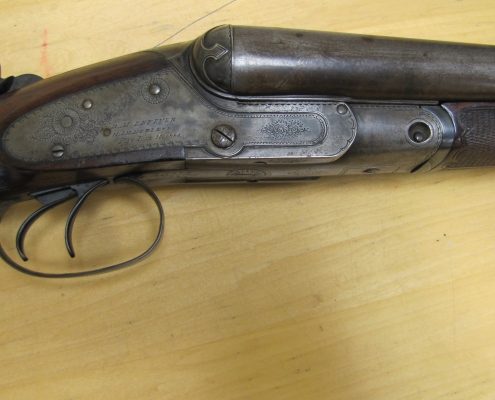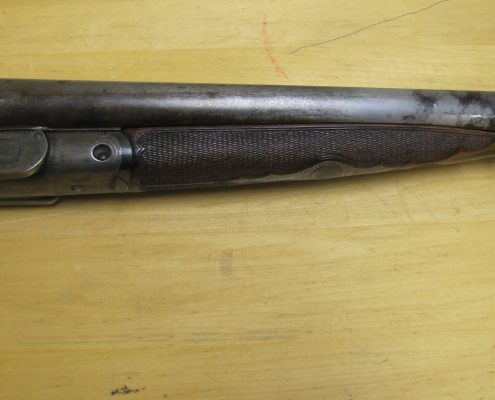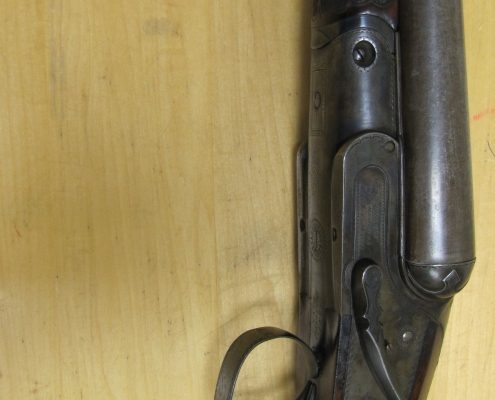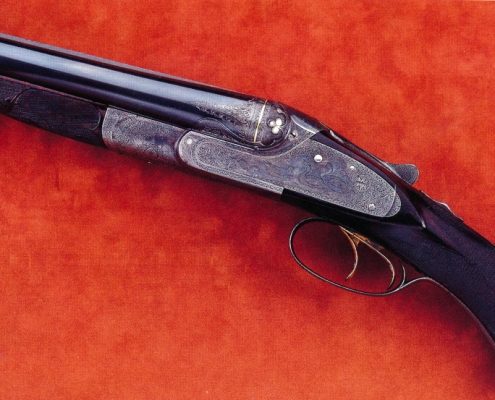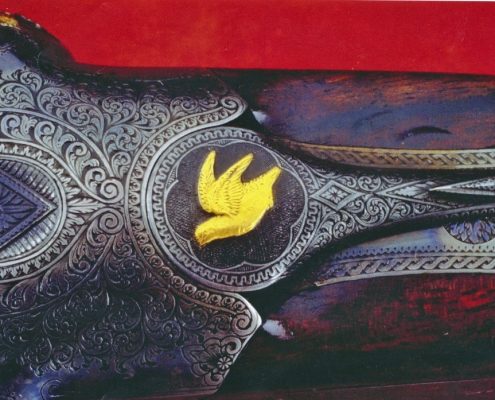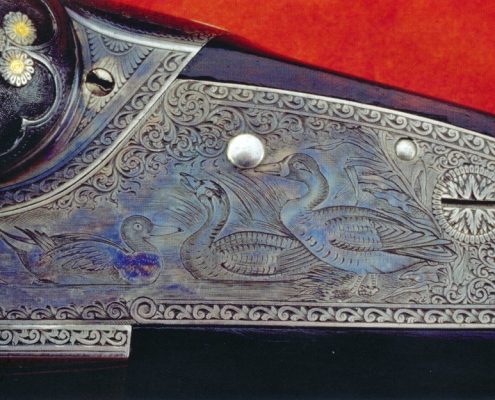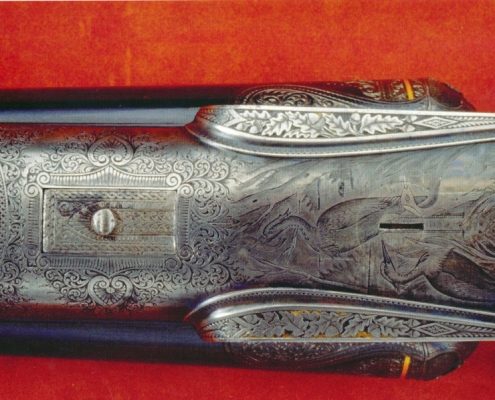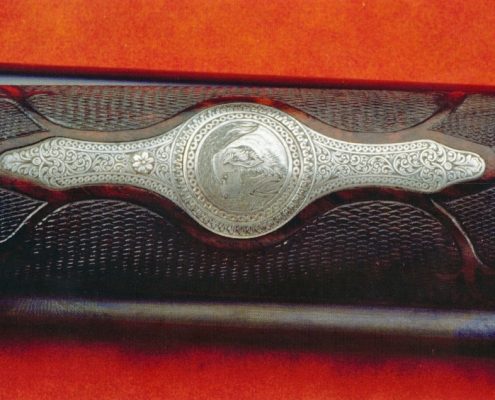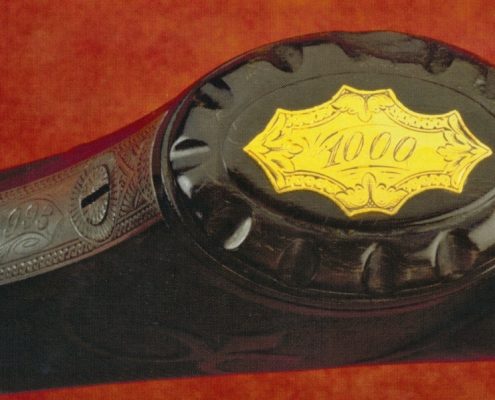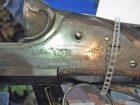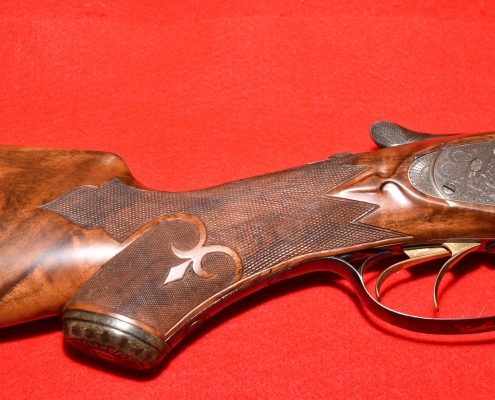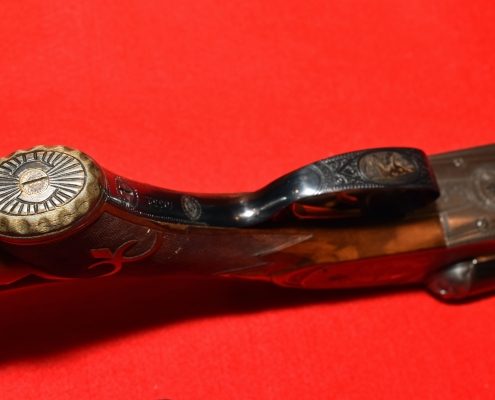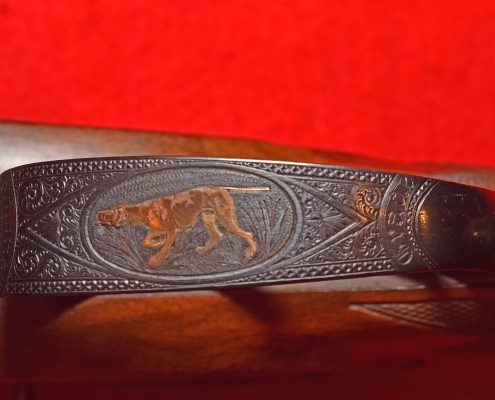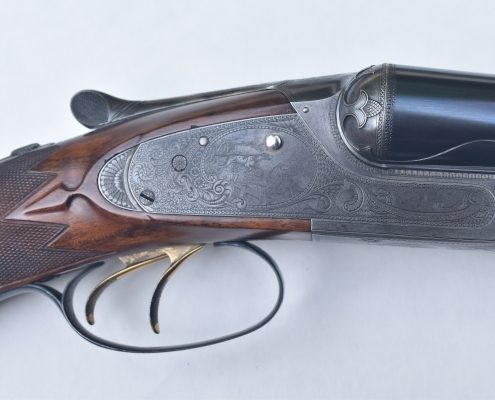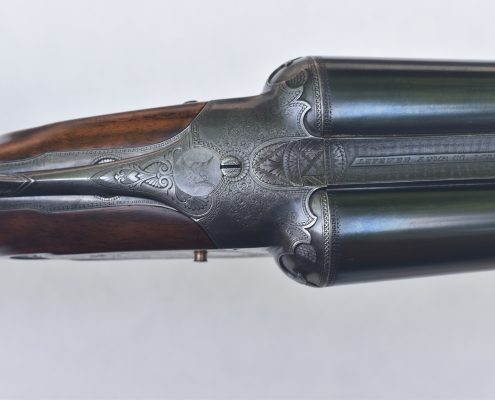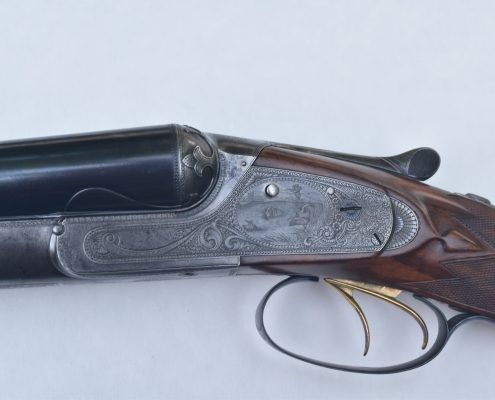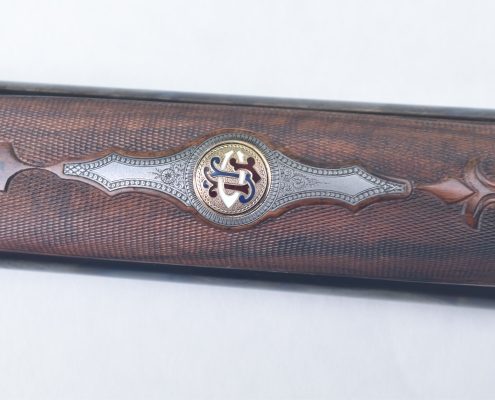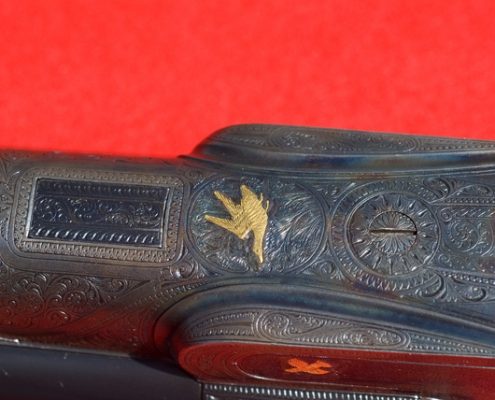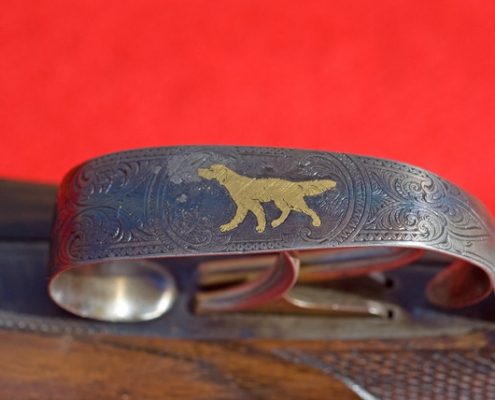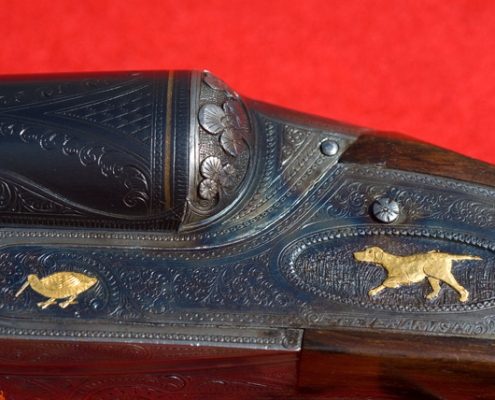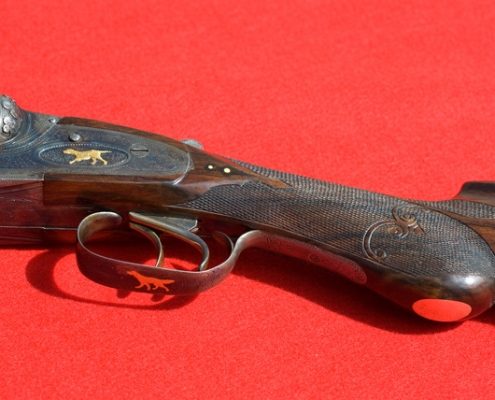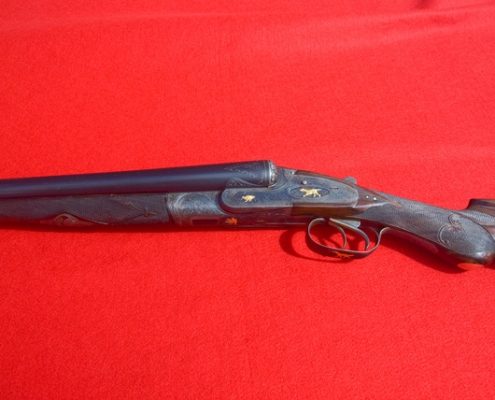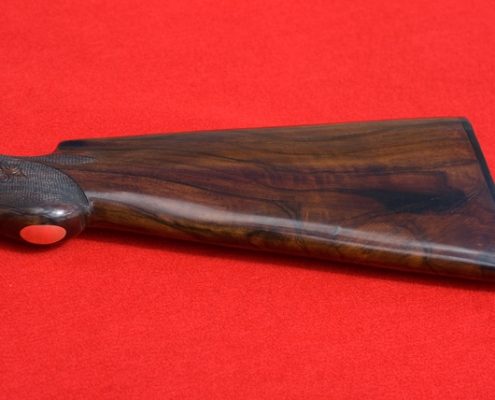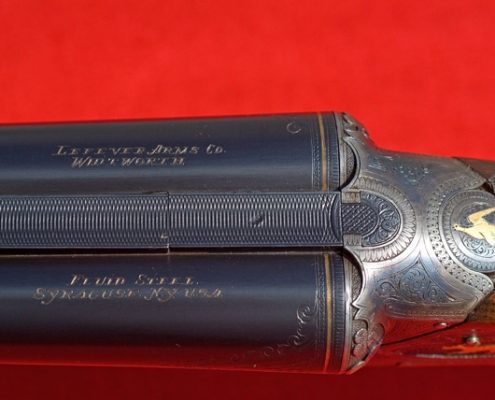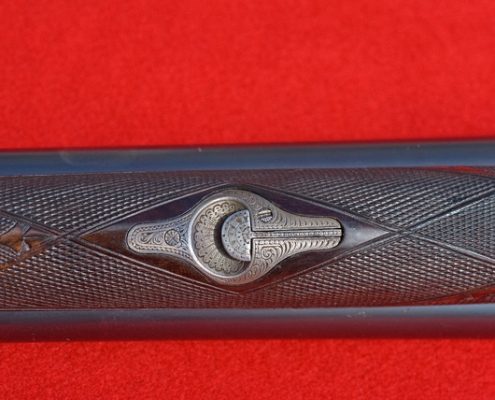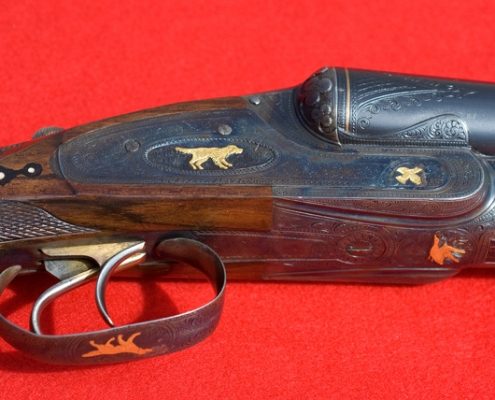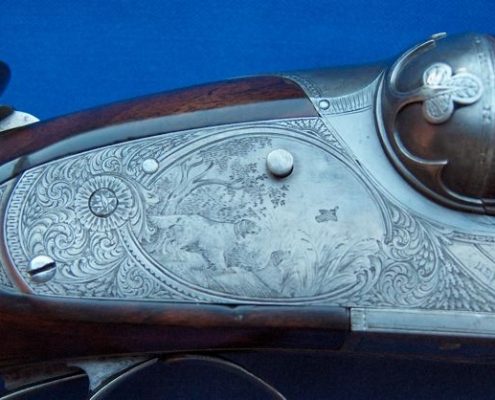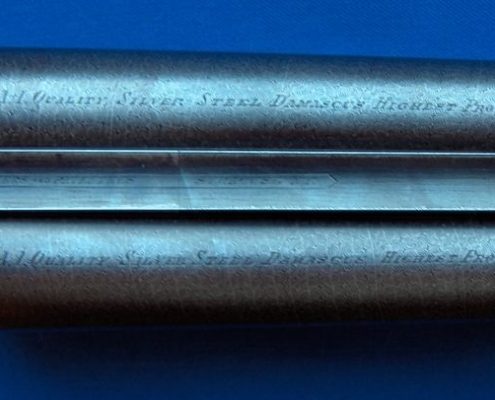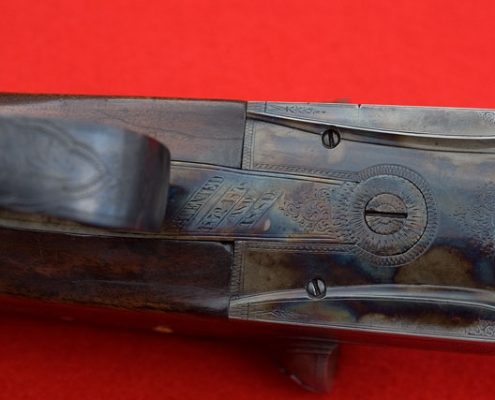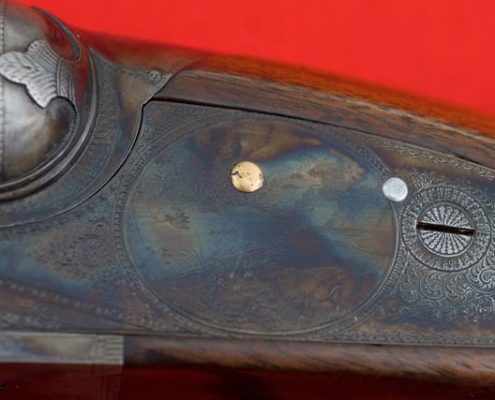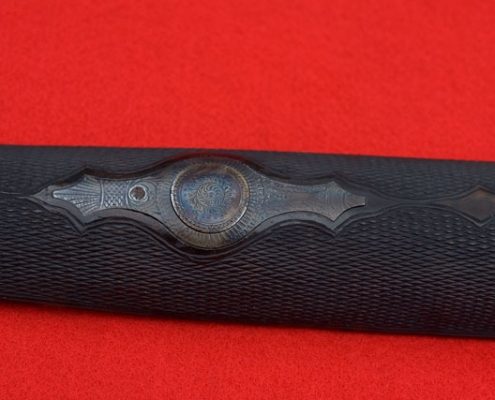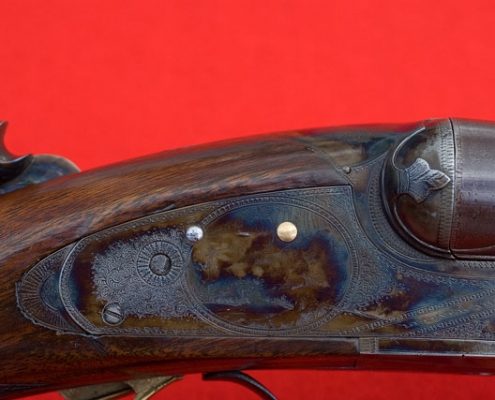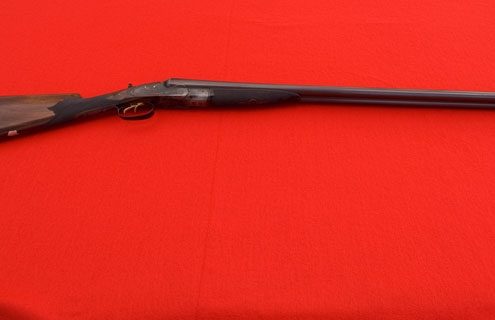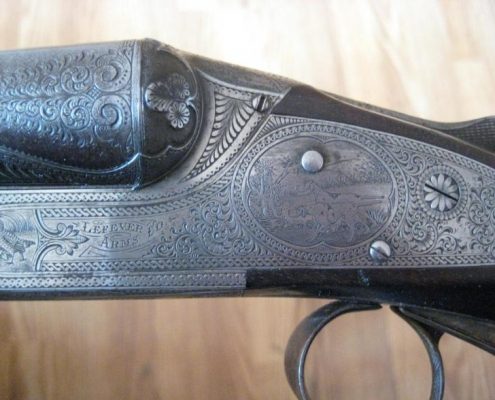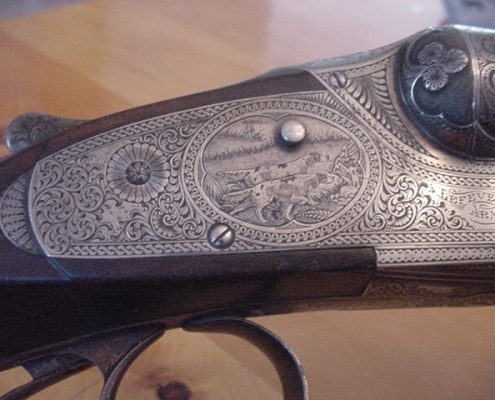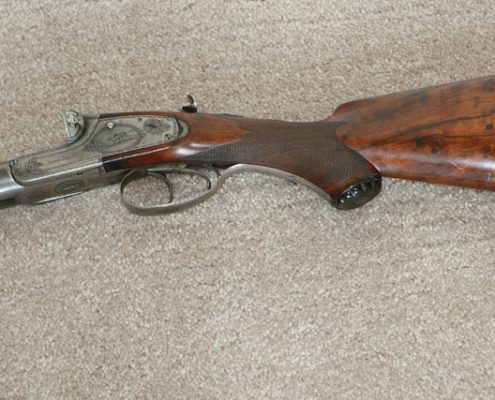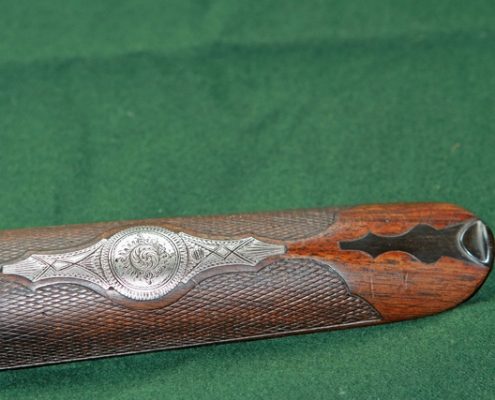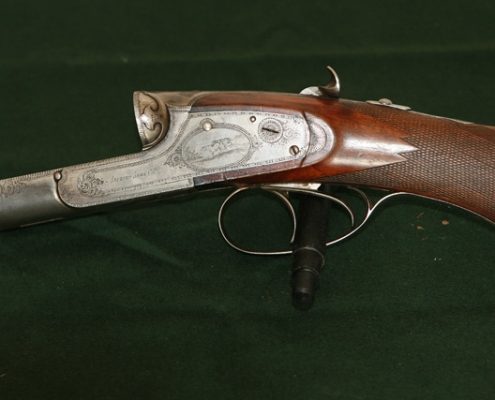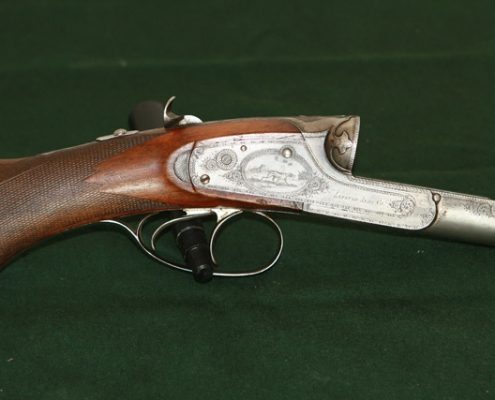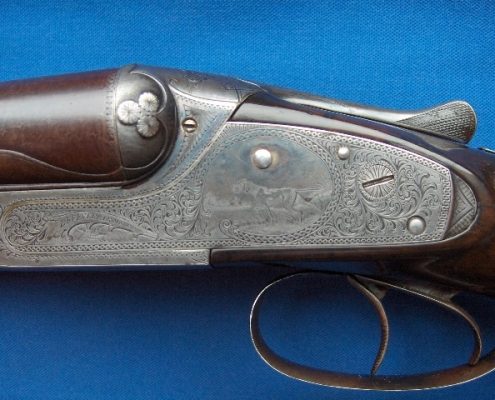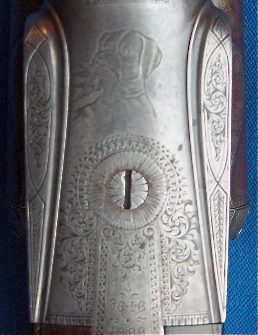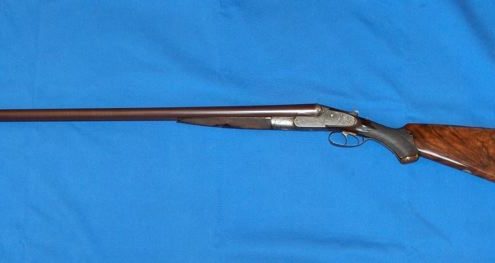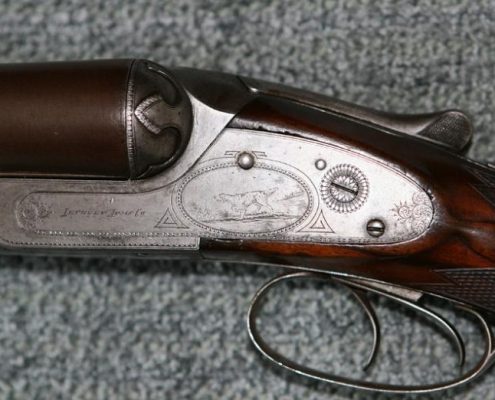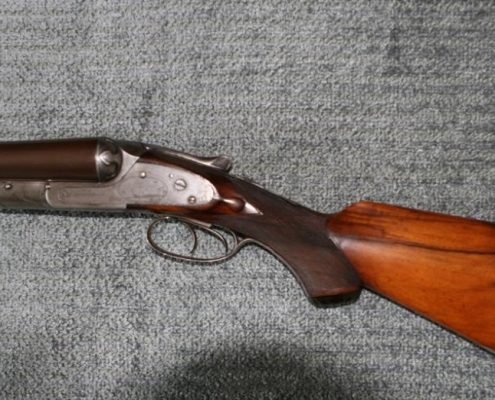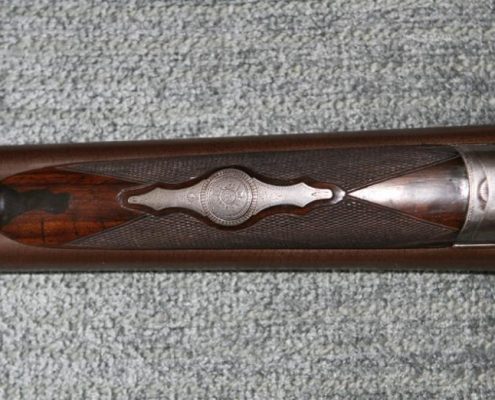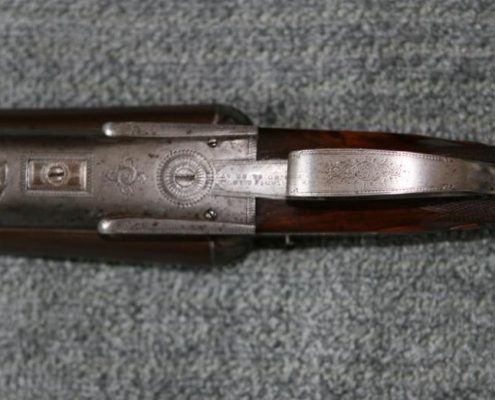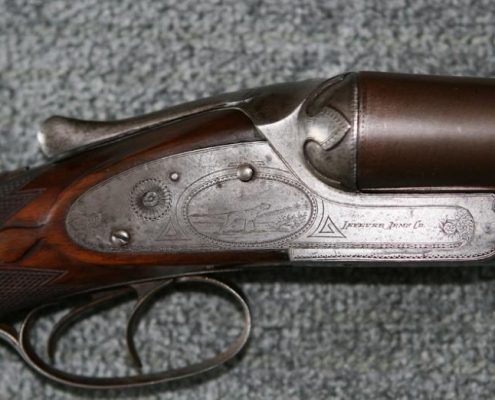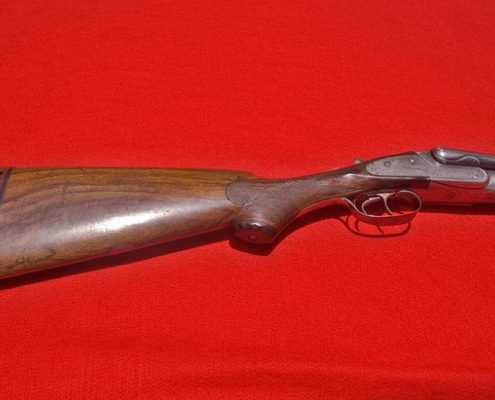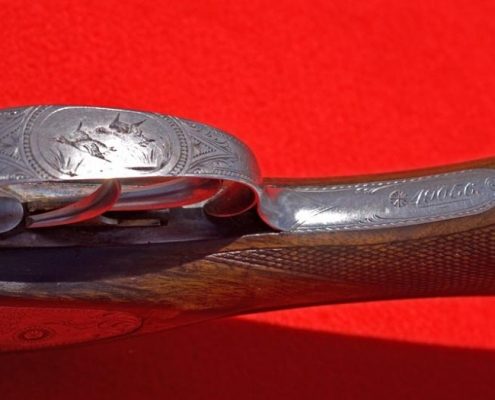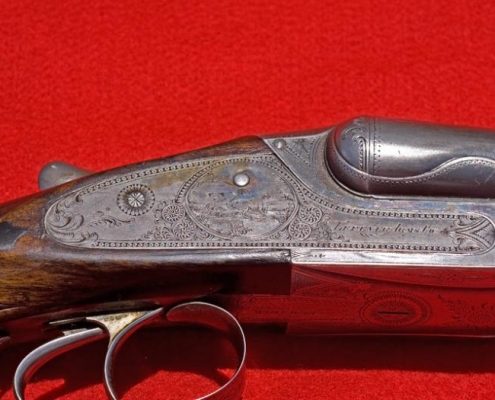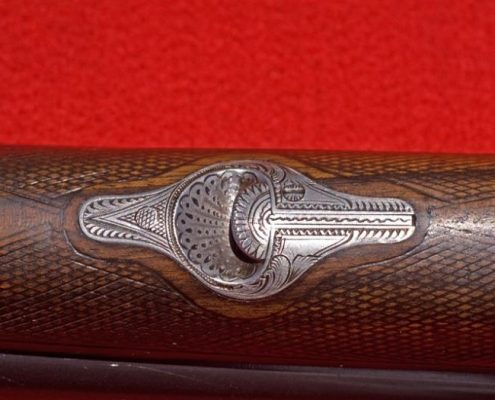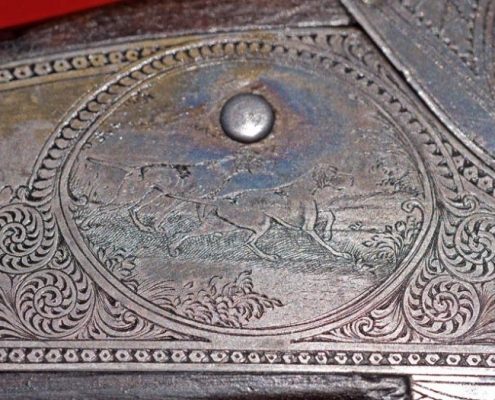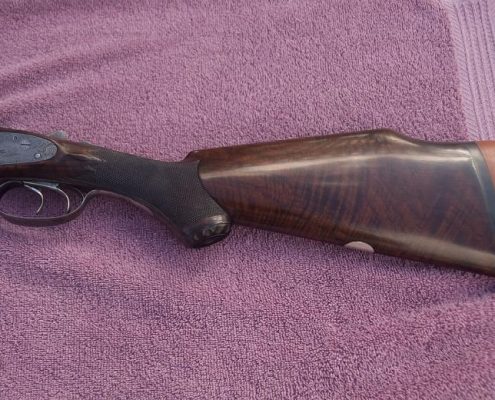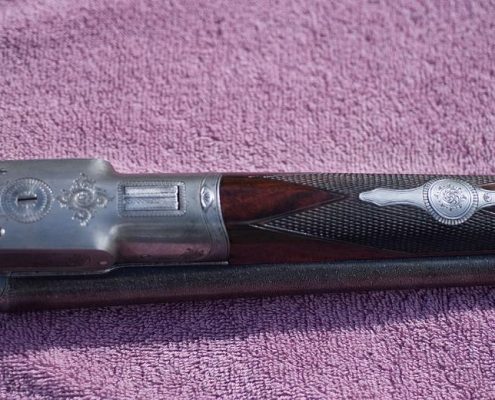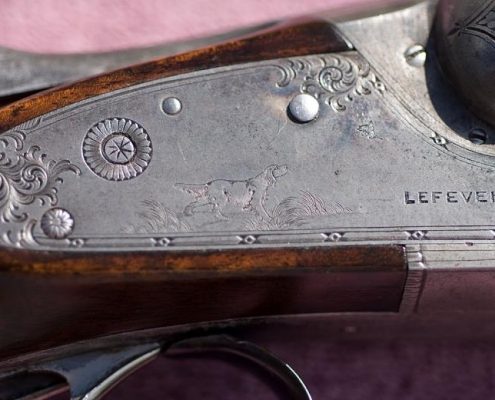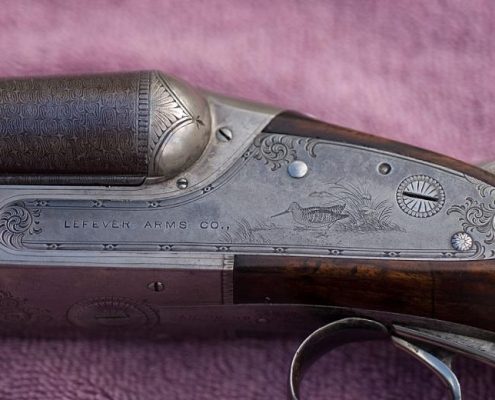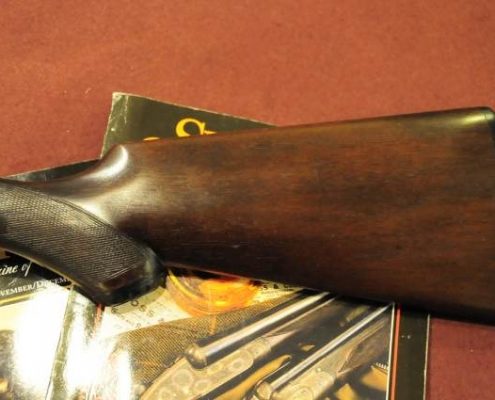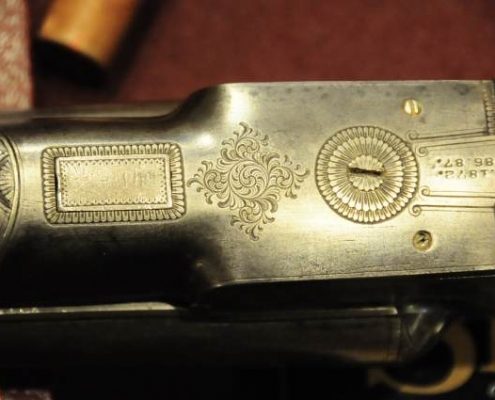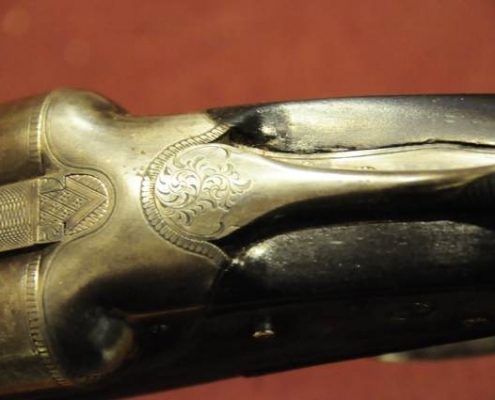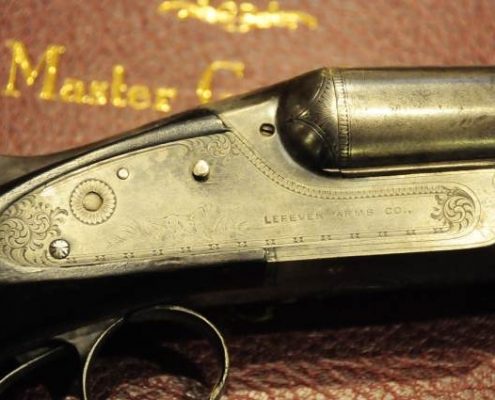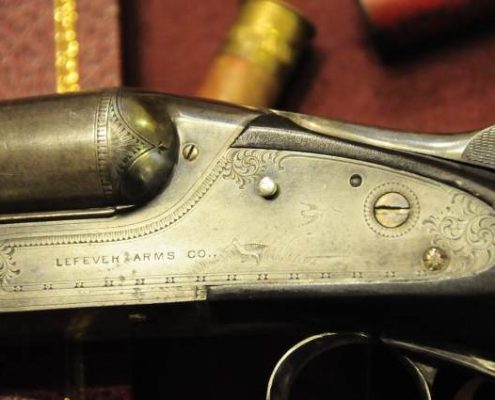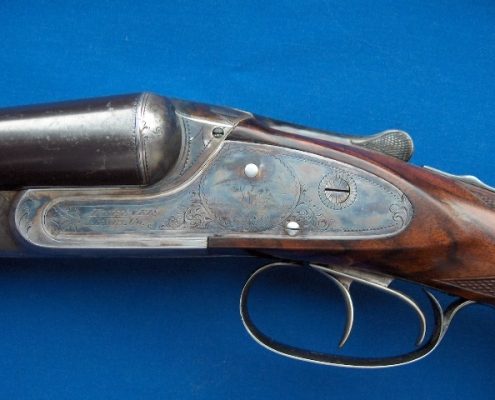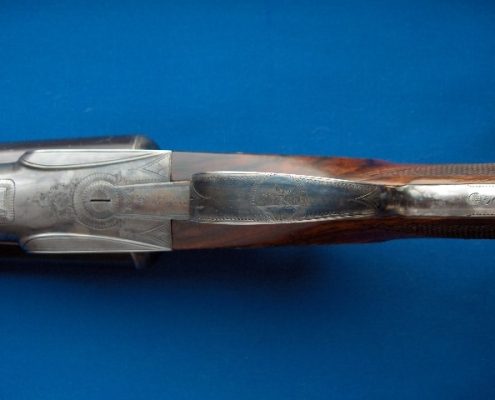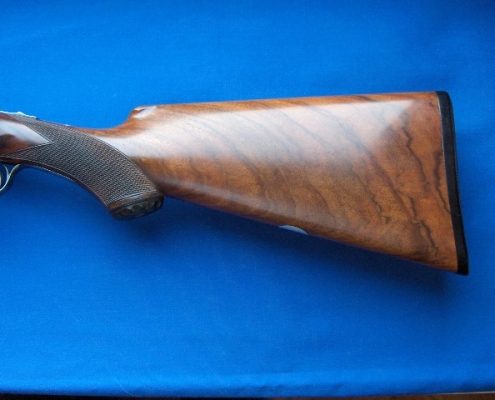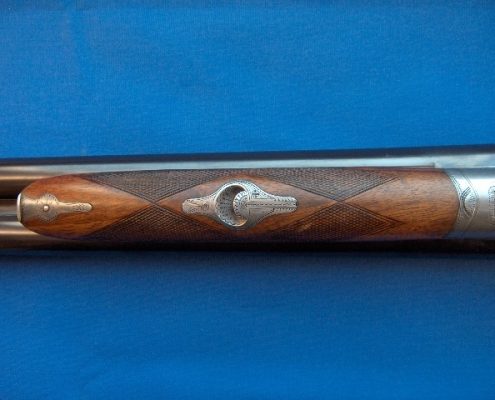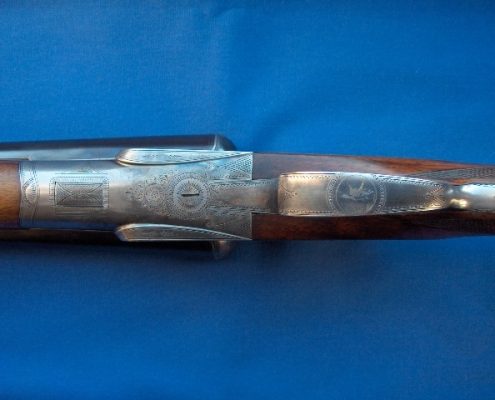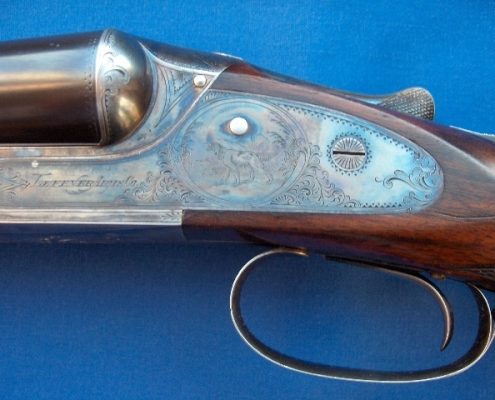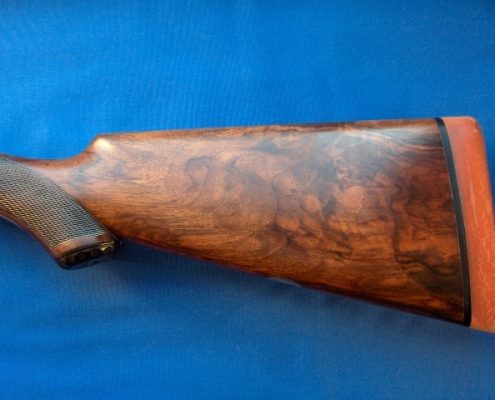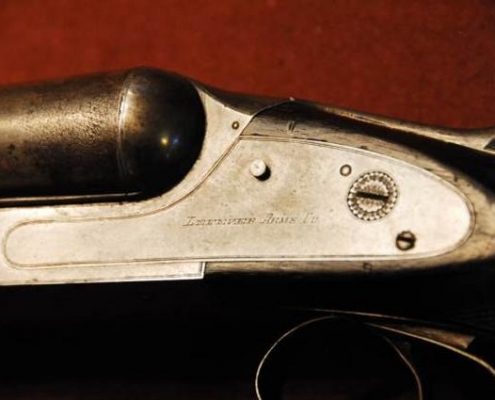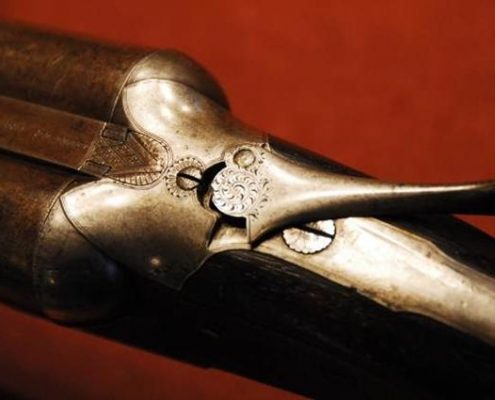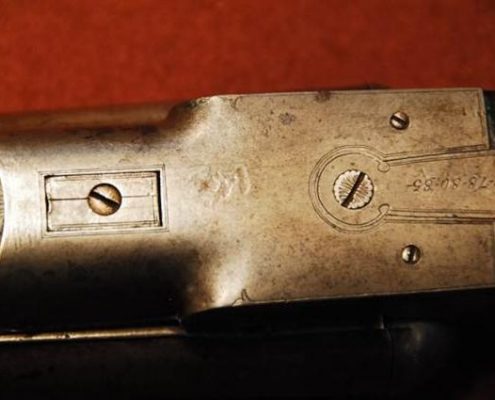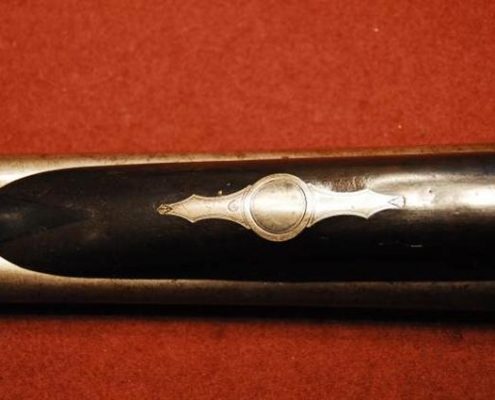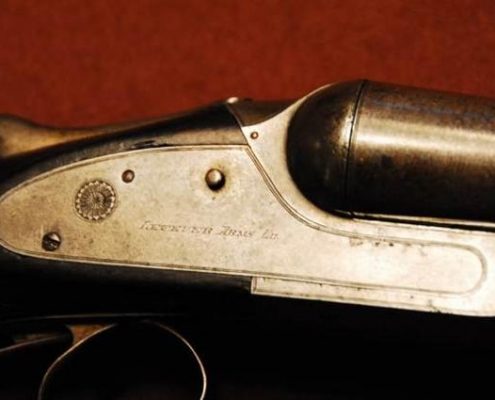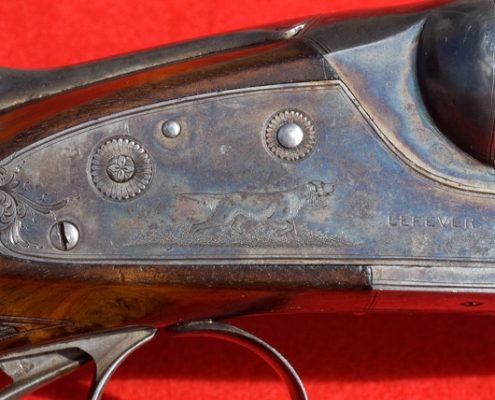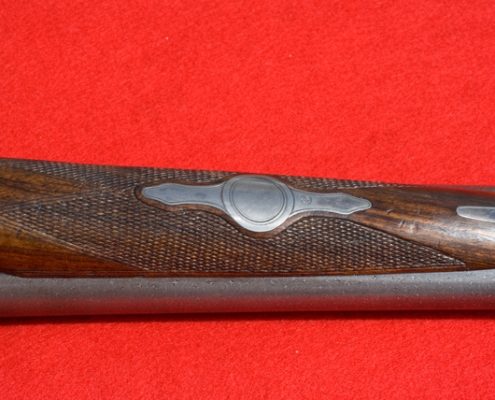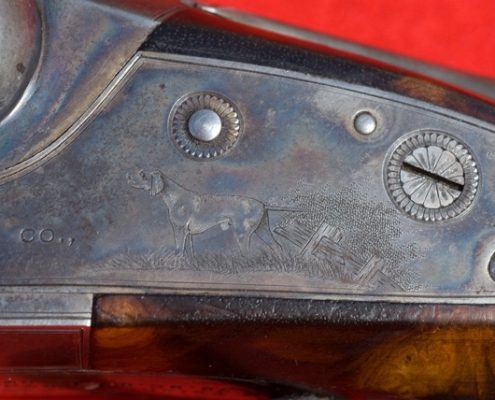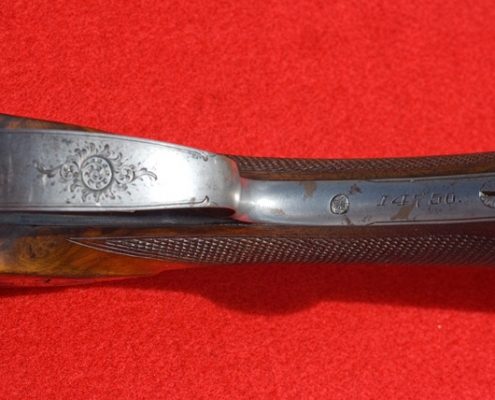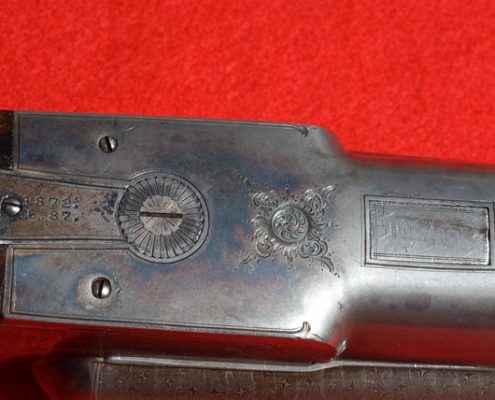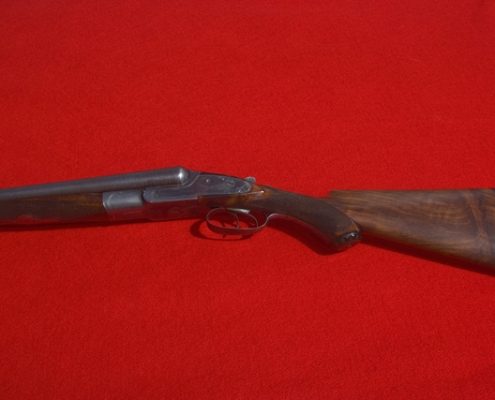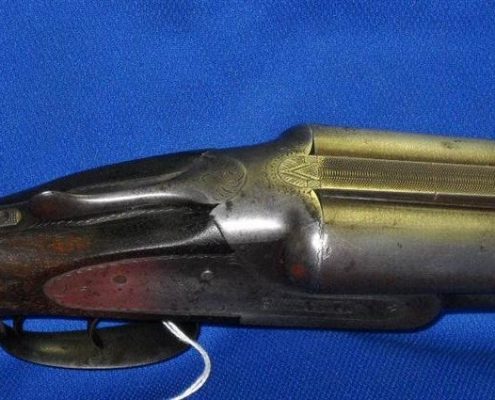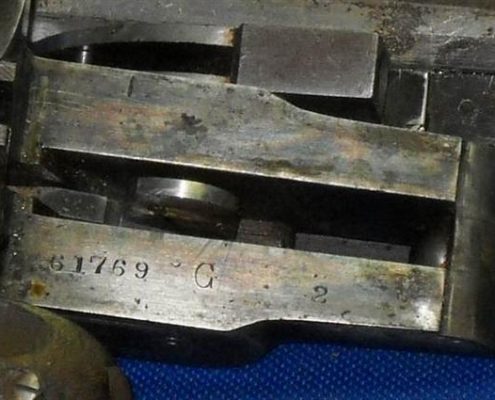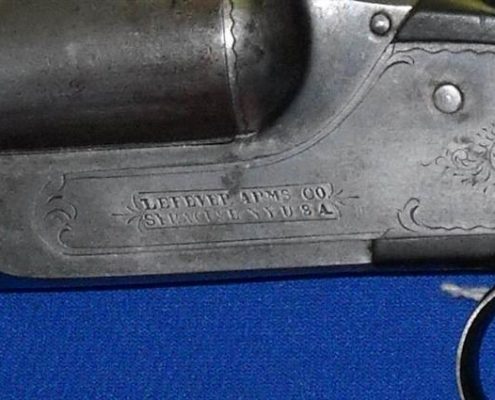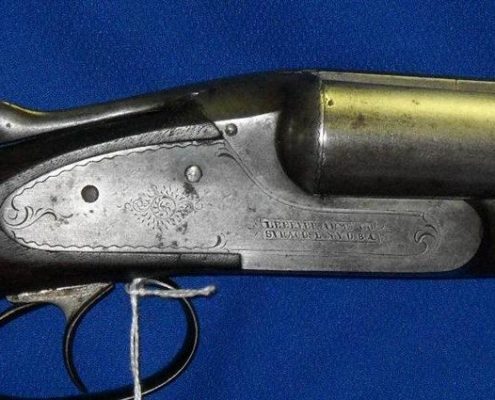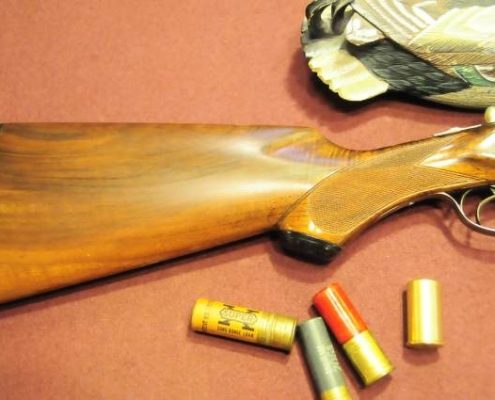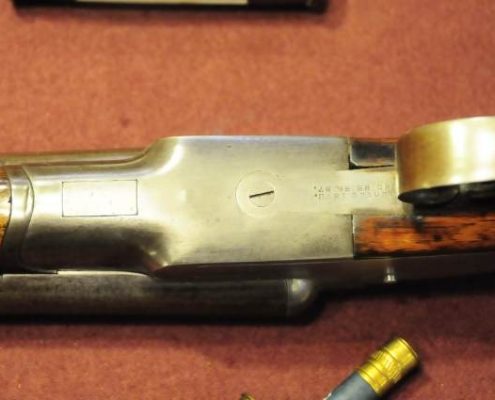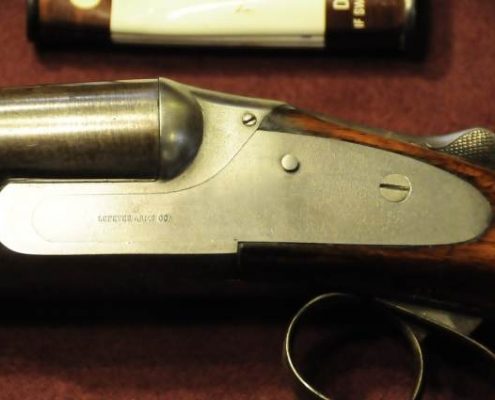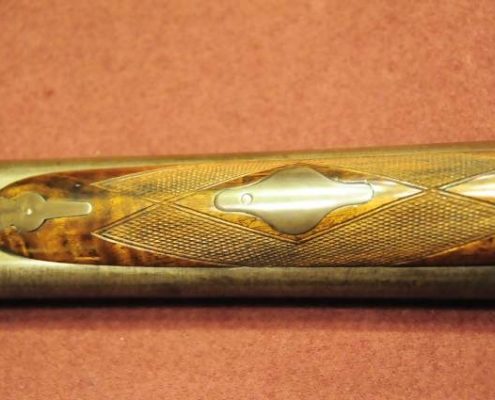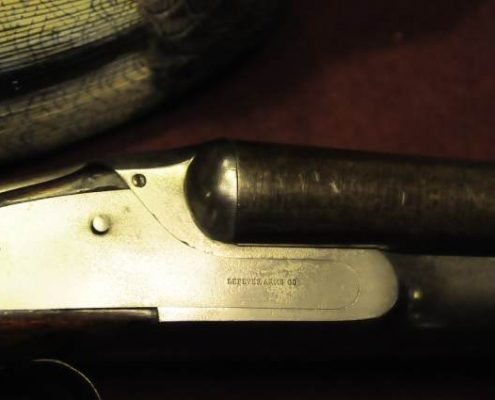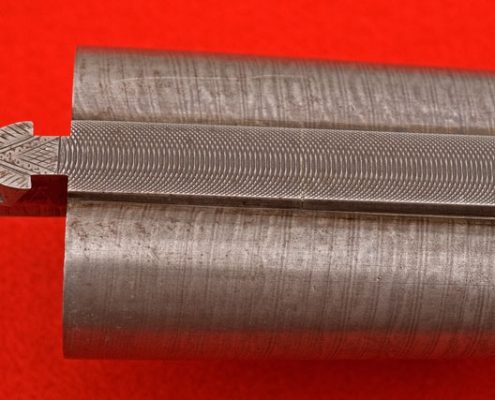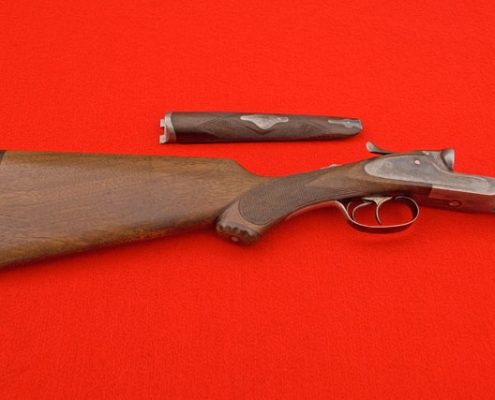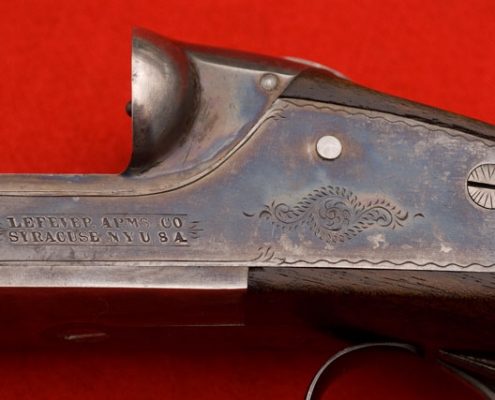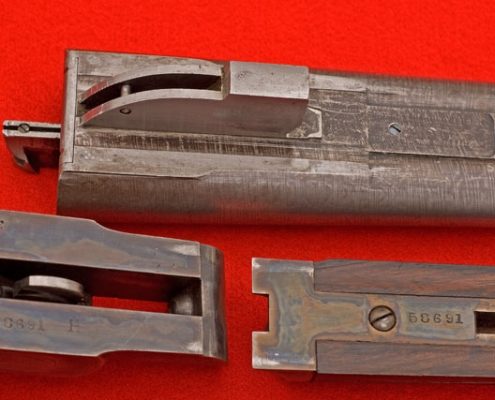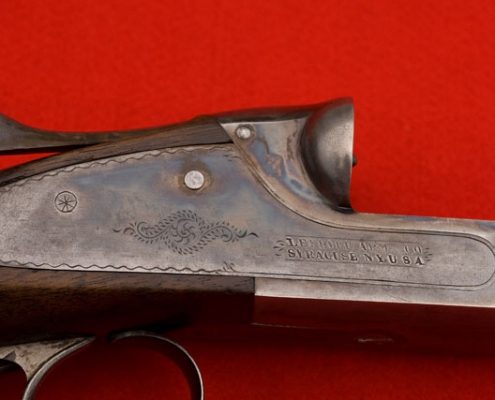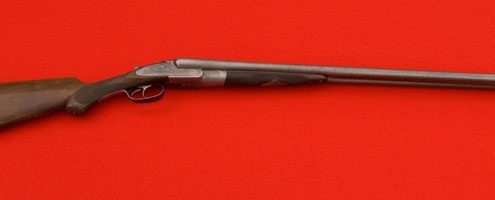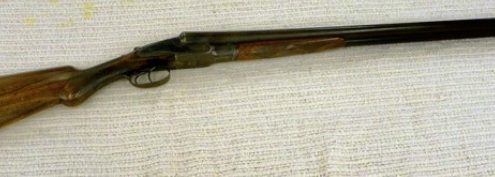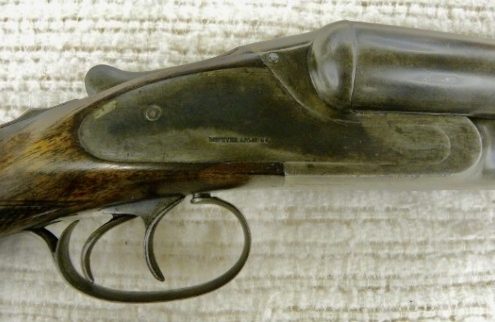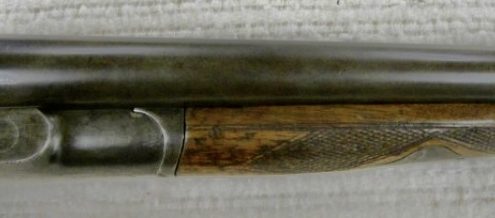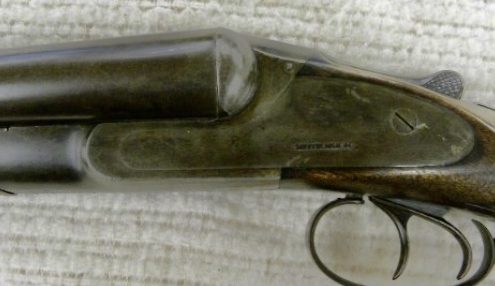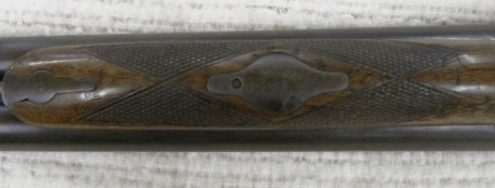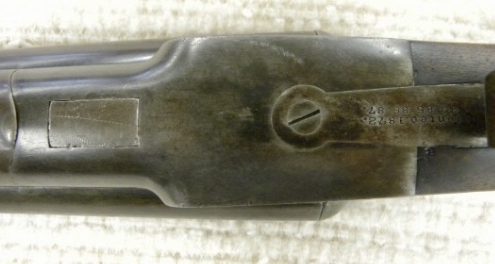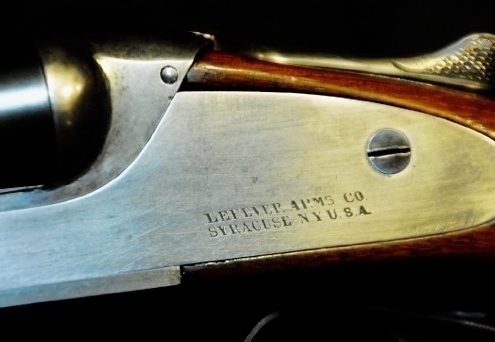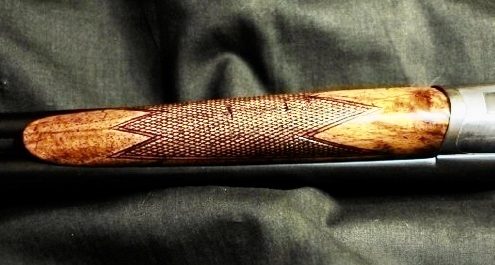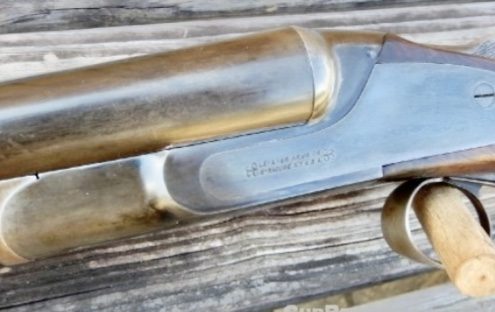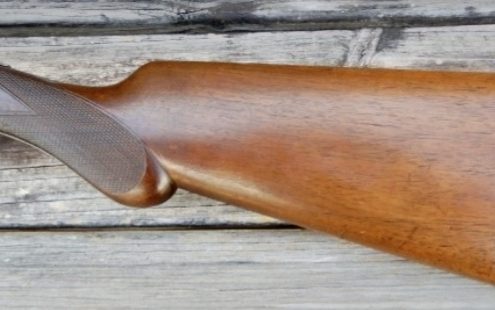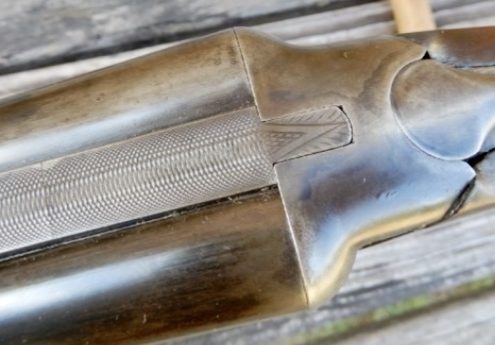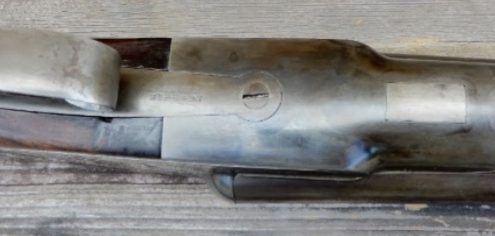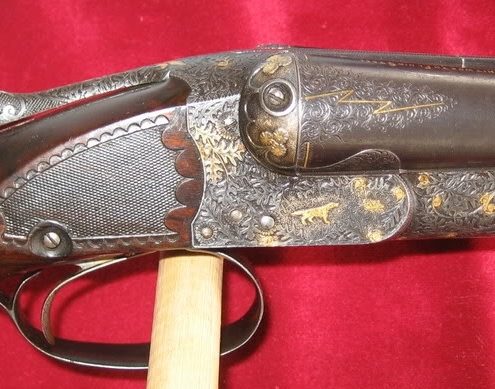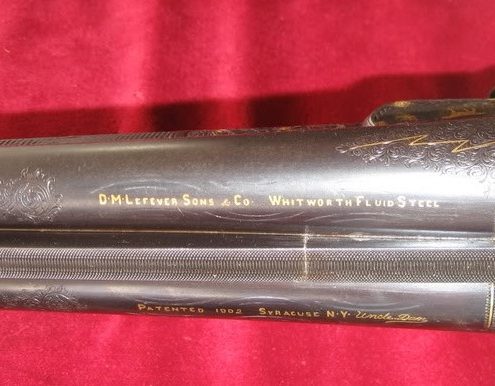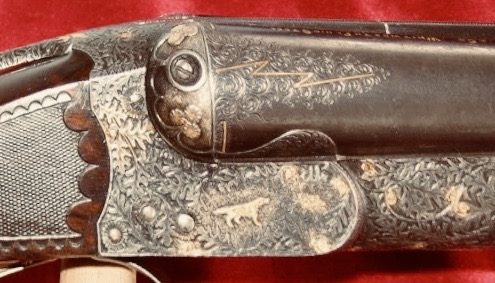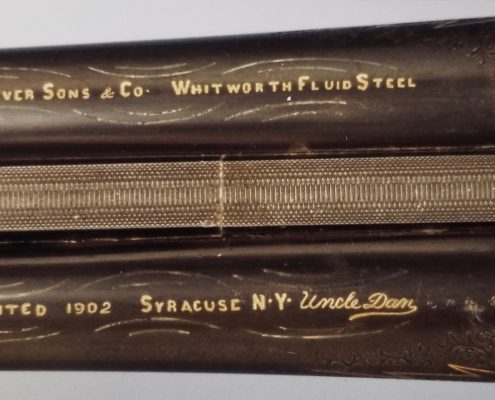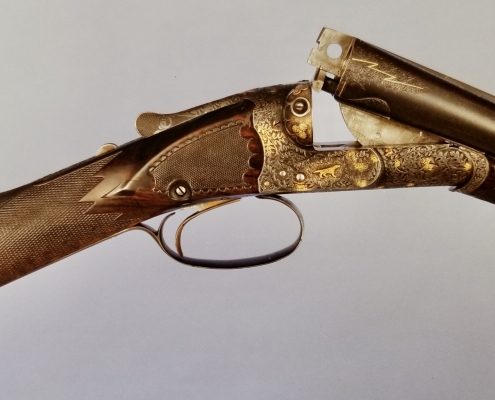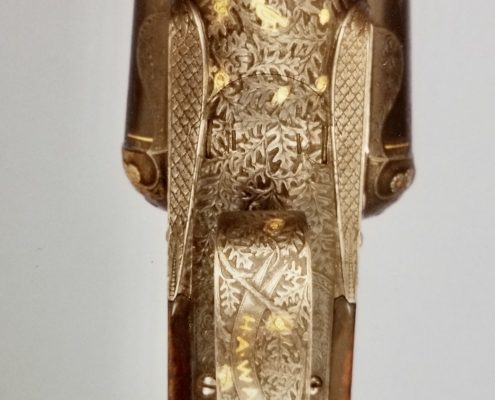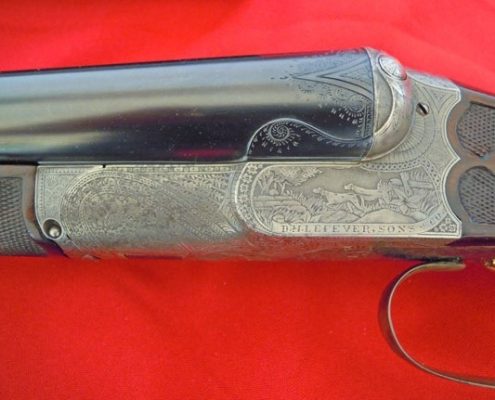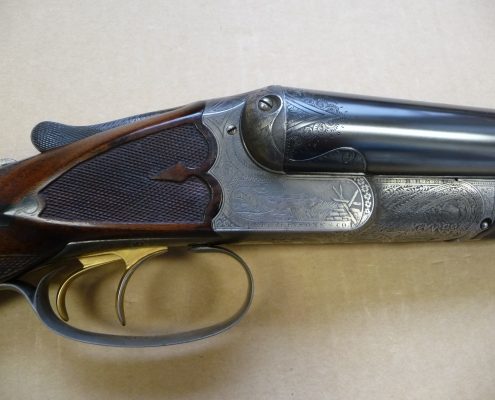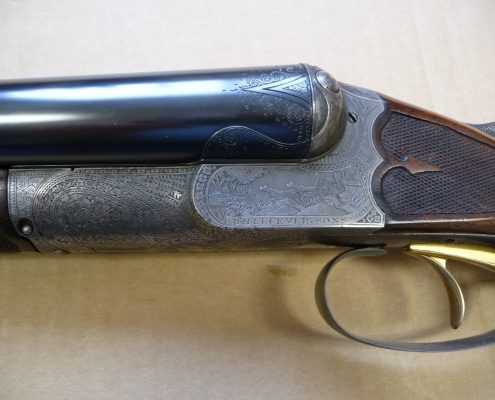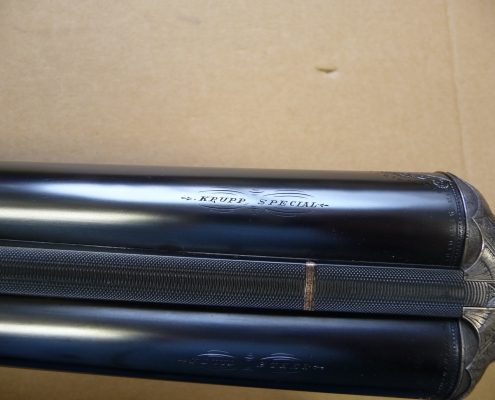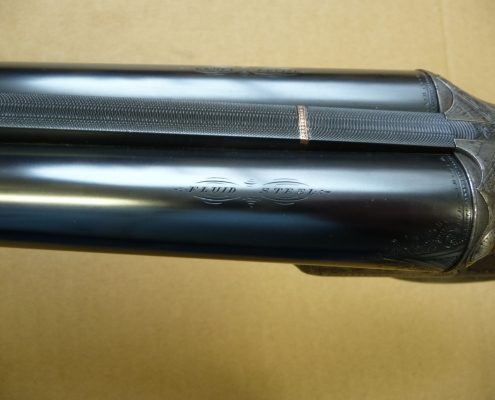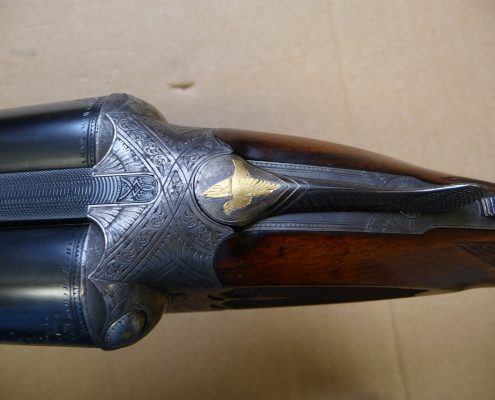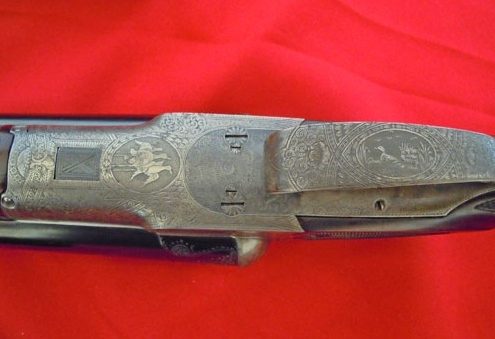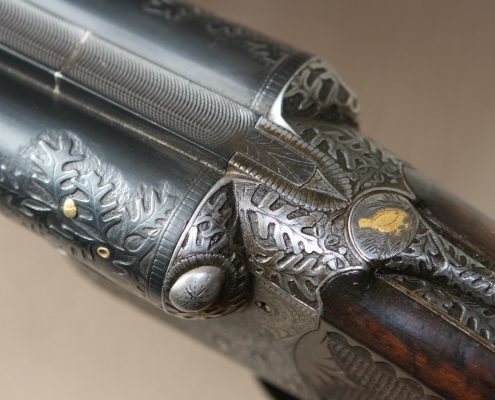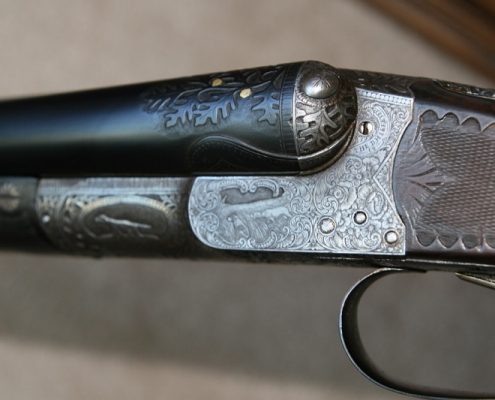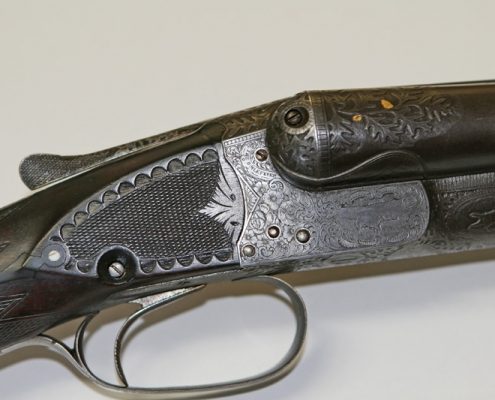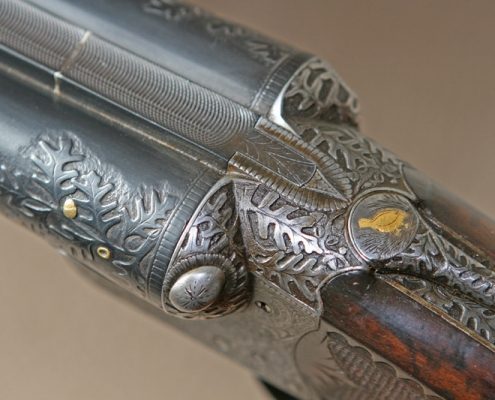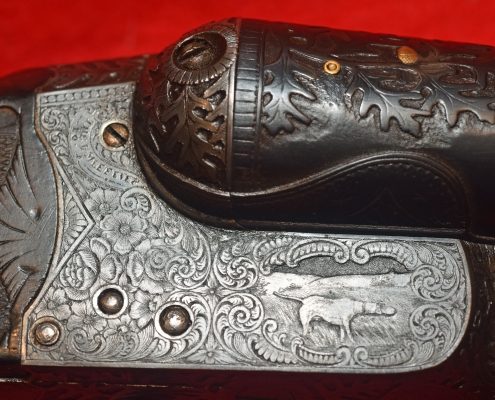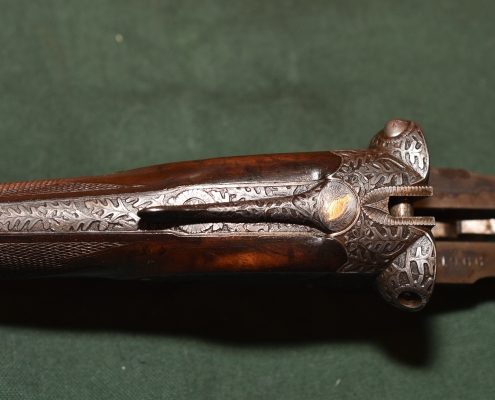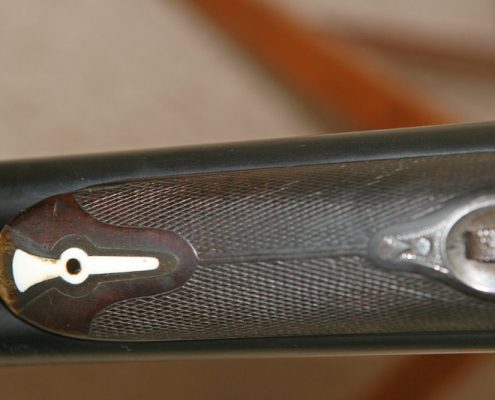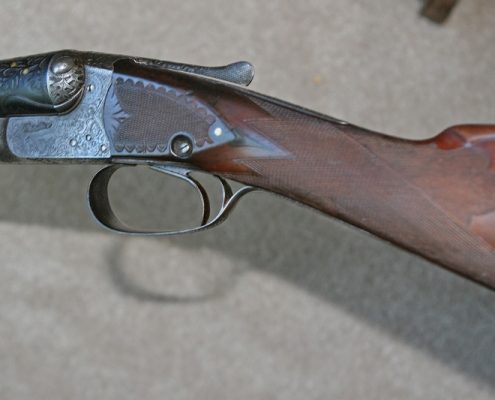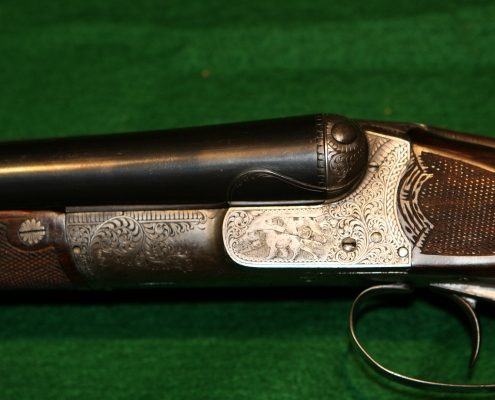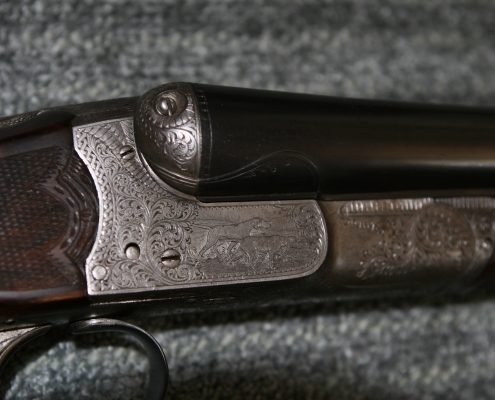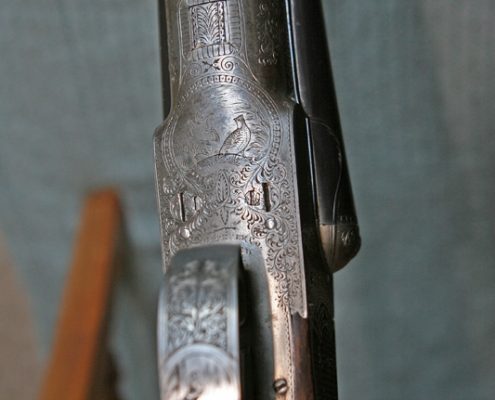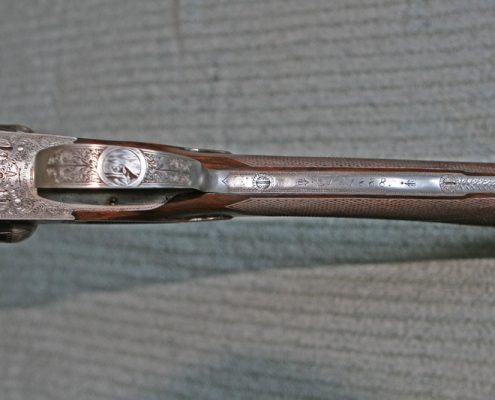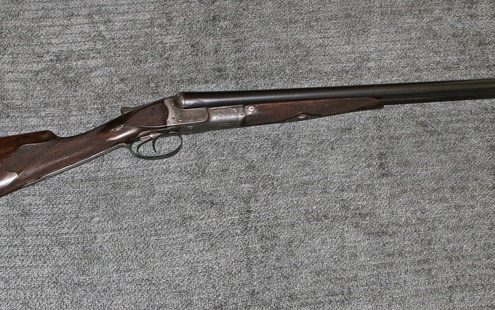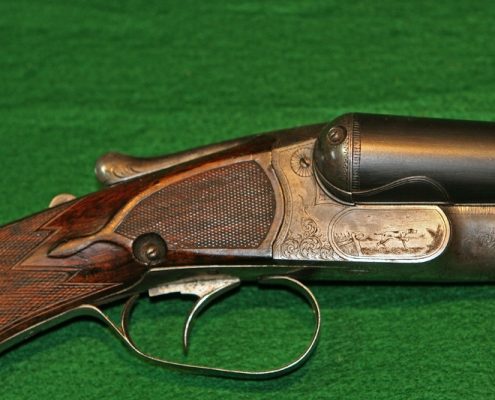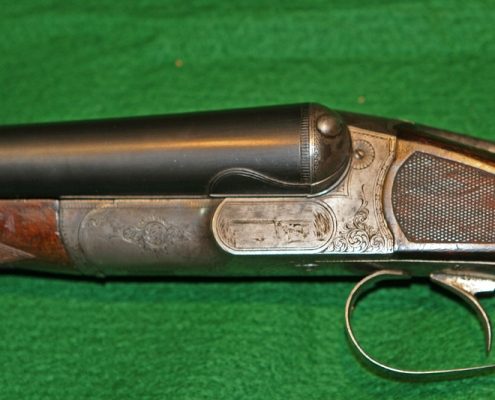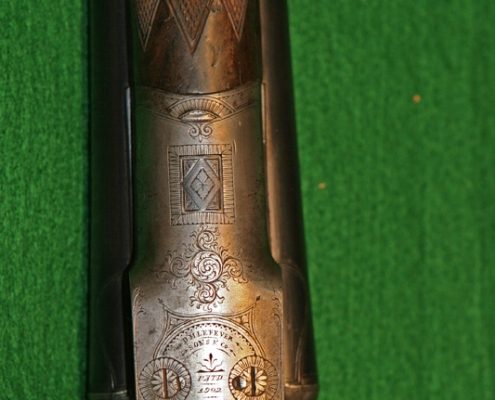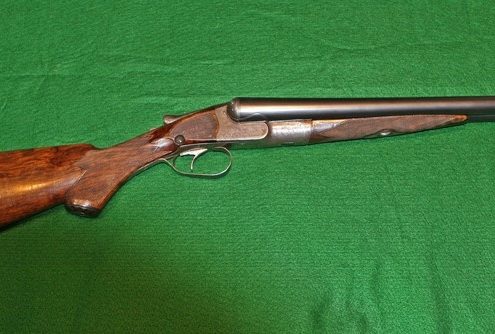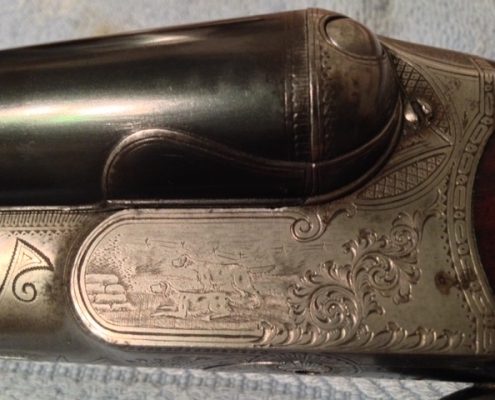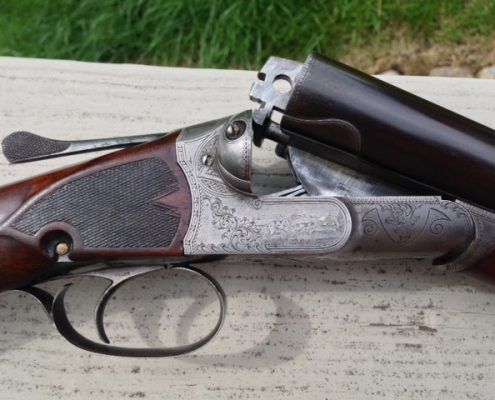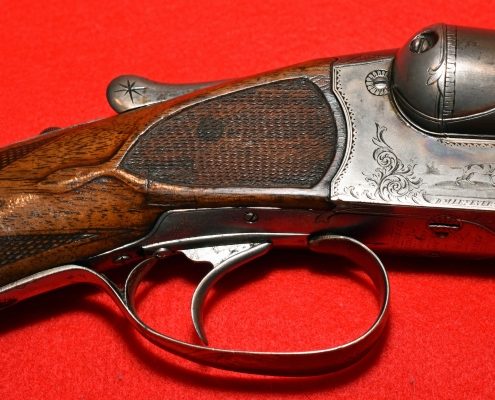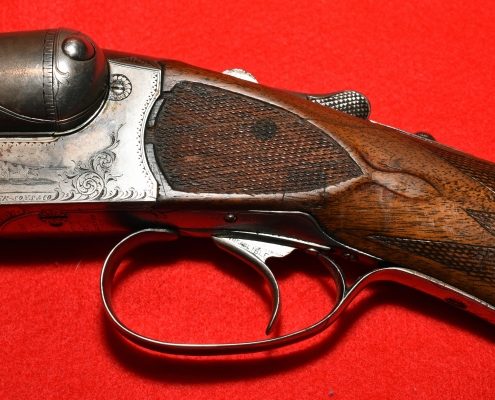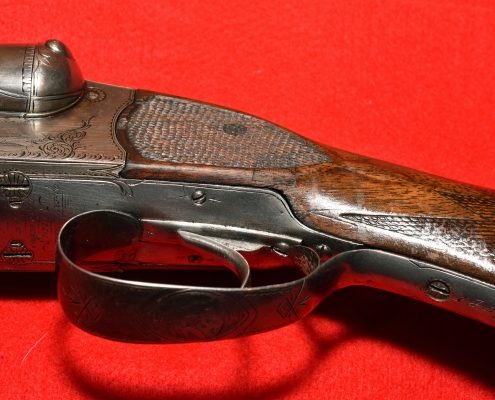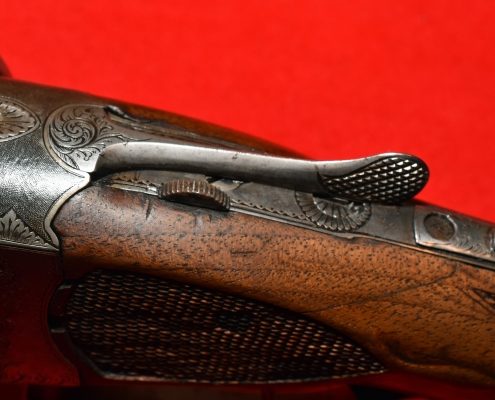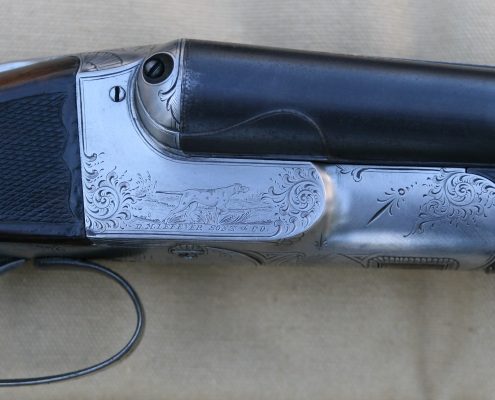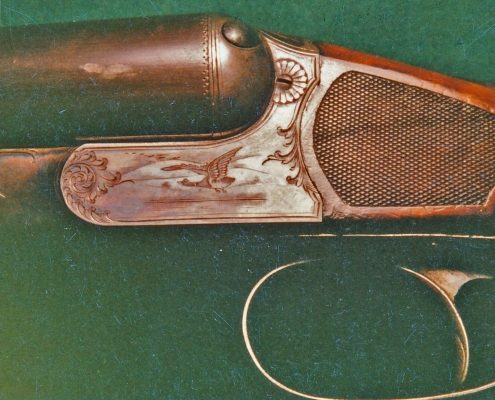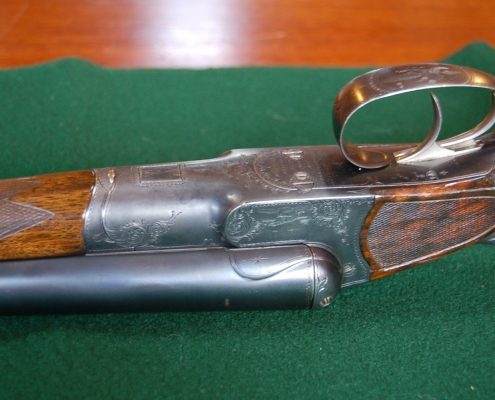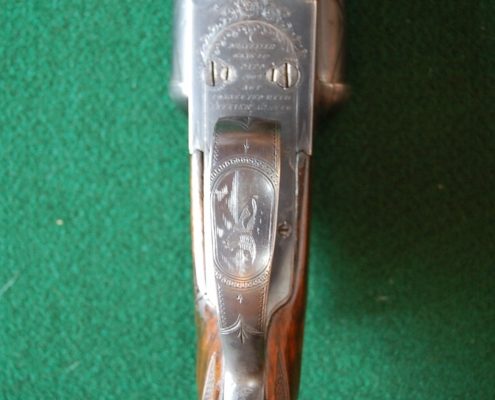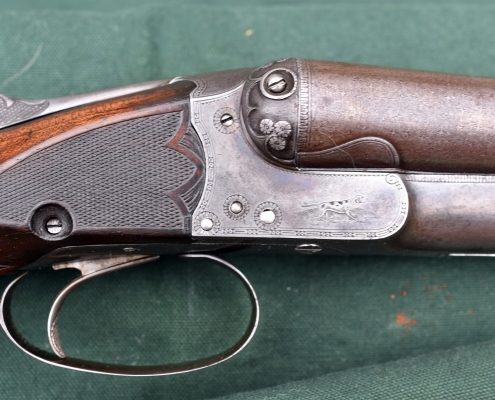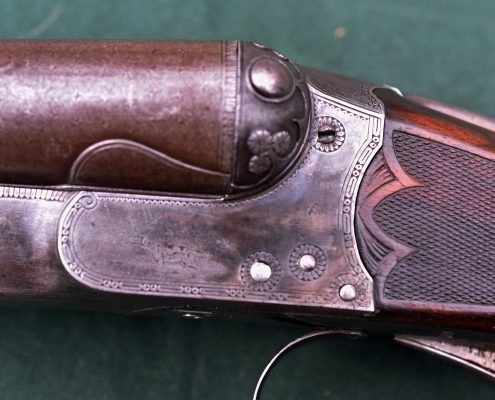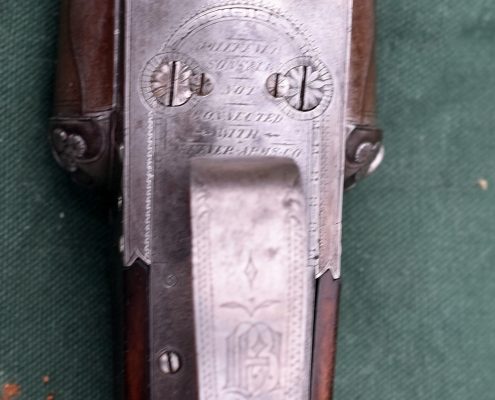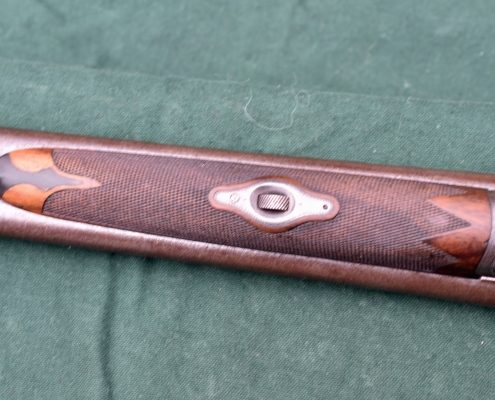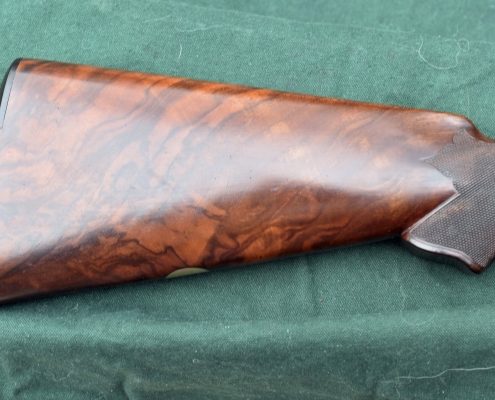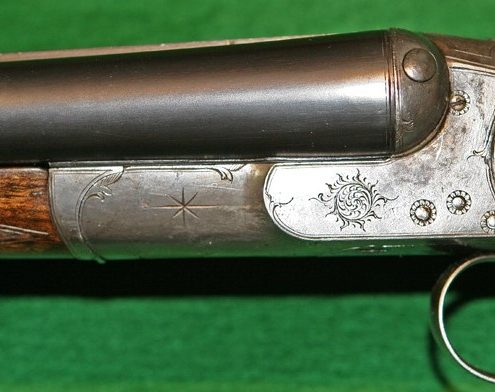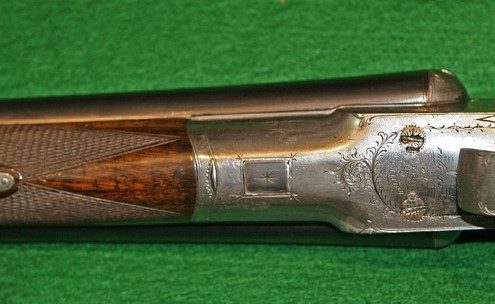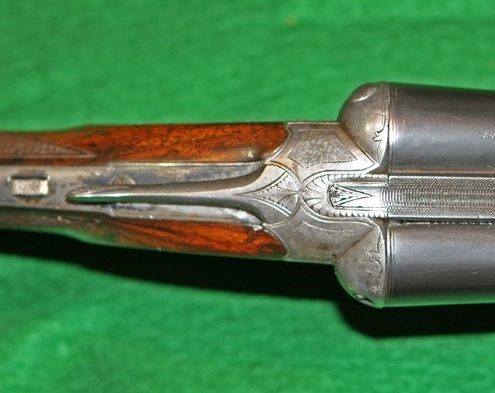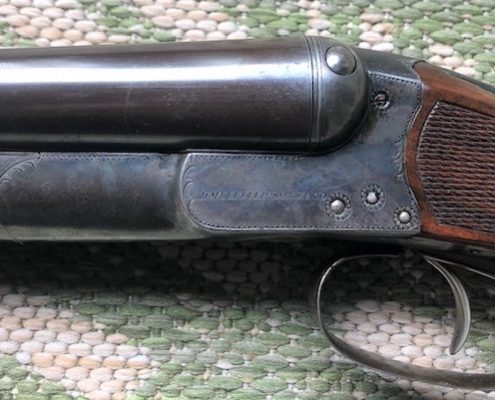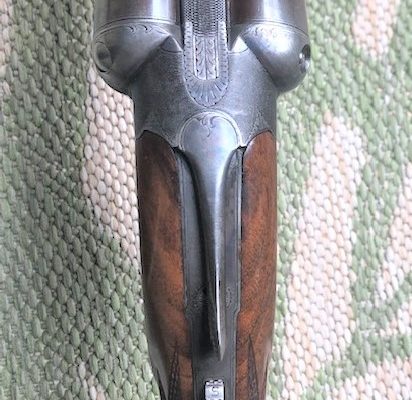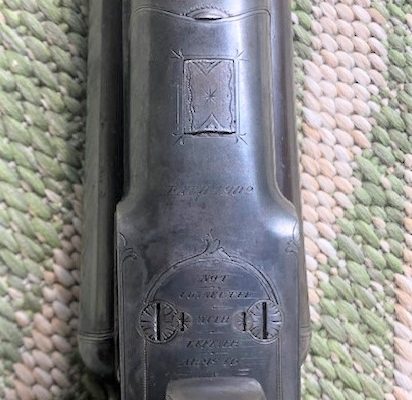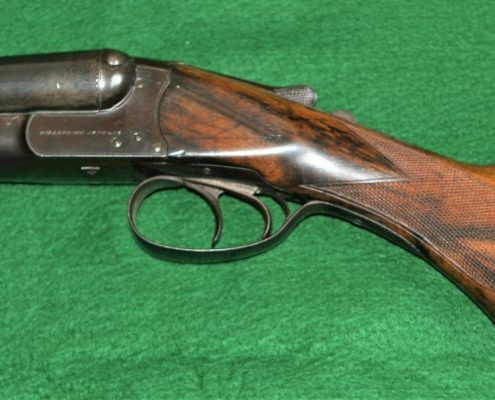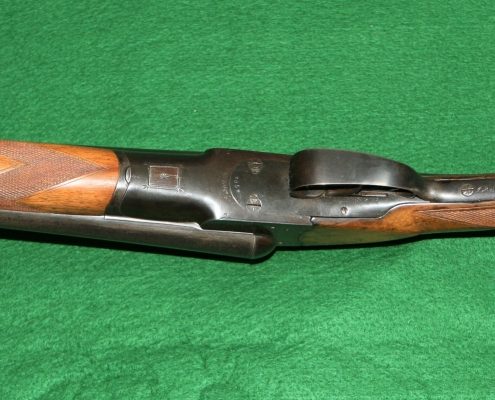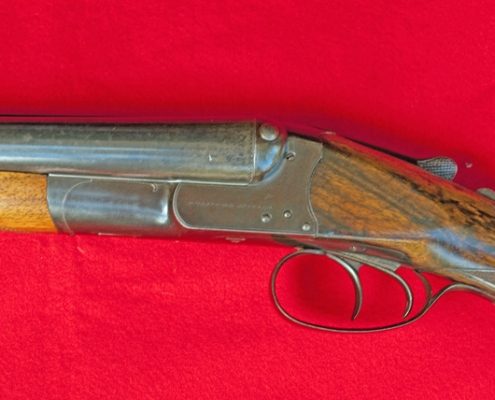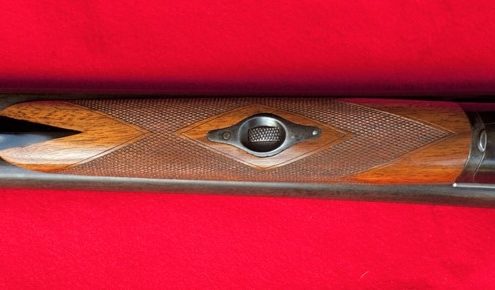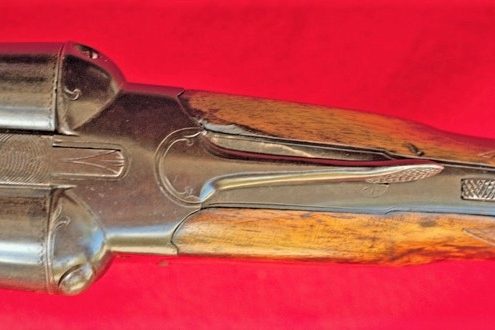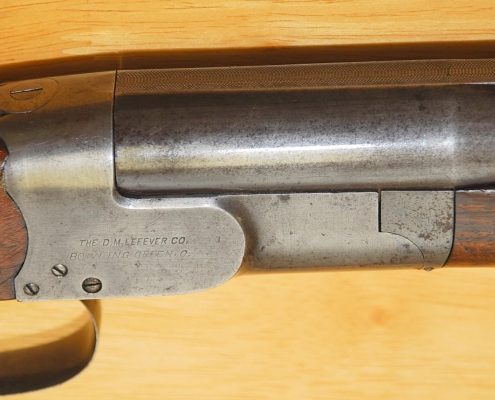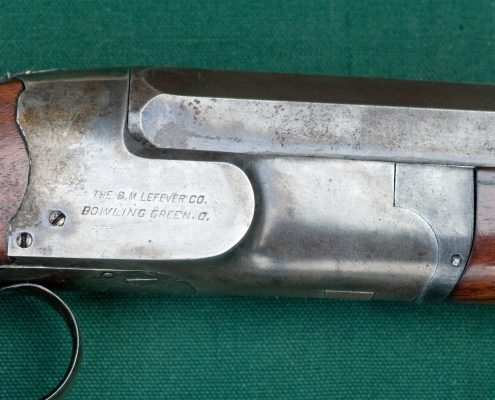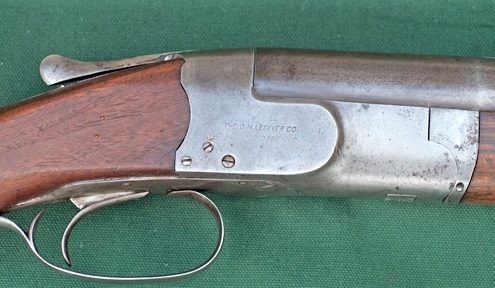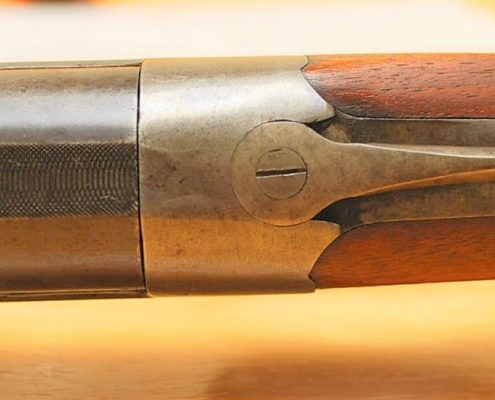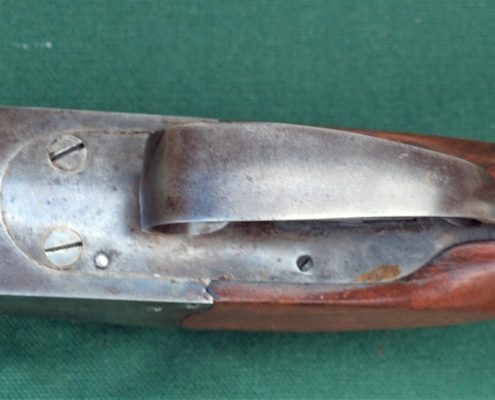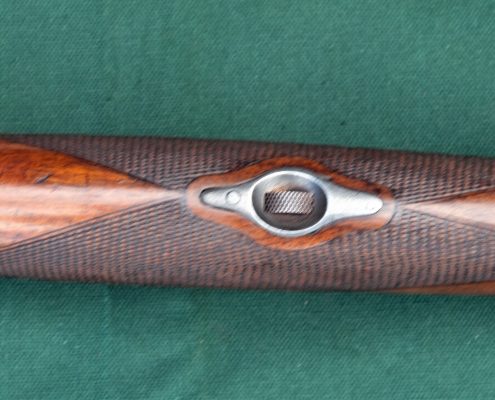D. M Lefever Canandaigua, NY 1857-1861
Daniel Myron Lefever began his independent career by buying the gunshop of his mentor Robert Antis on June 10, 1857 in Canandaigua, NY. He married Sarah Stead the next day. All of the guns made in this period were muzzle loaders. Both “mule ear” (red background) and “rabbit ear” (green background) hammer locks were used. Nothing is known of the quantity of guns produced in this period. They were not serial numbered. The quality seems to vary. Whether the quality improved over time is not known. They are, indeed, rare.
Lefever and Ellis, Canandaigua, NY 1861-1867
Lefever joined with James Ellis of Canandaigua to form Lefever and Ellis in 1861. The pair first found fame with the production of .50 caliber telescoped sharpshooter rifles for a Company of Sharpshooters formed out of Rochester, NY to serve in the Civil War. Lefever and Ellis continued in the fashion of Dan Lefever with the production of muzzle loading shotguns, rifles, and combination guns in both “mule ear” and “rabbit ear” configurations.
D. M. Lefever, Auburn, NY 1869-1872
D. M. Lefever left Canandaigua sometime in 1869 for Auburn, NY. Here he began working on his breech loading suns. Very little is known of this period. It appears he was working alone. There are very few examples of guns from this period and production numbers are unknown.
Dangerfield and Lefever, Auburn, NY 1872-1874
D. M. Lefever joined with financier Francis Dangerfield to form Dangerfield and Lefever. The patent of 1872 which included the thumb push opener was issued in Dangerfield’s name but assigned to Lefever. This firm made breech loading guns both from scratch and by converting muzzle loaders. The firm ended after a fire in 1873. Again the number of guns produced is unknown. It appears most of them were conversions.
Barber and Lefever, Syracuse, NY 1874-1876
Lefever left Auburn for Syracuse, NY where he joined with Lorenzo Barber, a famed Civil War Chaplin and marksman. They continued to make breech loading shotguns and continued converting muzzle loaders to breech loaders. The quality of the guns continued to improve.It is not known how many guns were made in this partnership which lasted only two years.
Nichols and Lefever Syracuse, NY 1876-78 A Grade
D. M. Lefever joined with machinist and financier John Nichols to form Nichols and Lefever. By this time Lefever had nearly perfected his hammer gun design and had, for the most part, abandoned muzzle loader conversions. Early on they decided to Grade their guns and mark them as such to avoid retailers claiming that guns were graded higher than intended by the factory to increase the price.
Nichols and Lefever Syracuse, NY 1876-78 B Grade
Nichols and Lefever were very successful in marketing a superior shotgun design. They were rewarded for their efforts at the St. Louis Bench Show and Sportsman’s Association with Medals for “The Best Breech-loading Shotgun made in America” and “The Best Breech-loading Shotgun made in the World”. There are rumors ( perhaps stared by Uncle Dan himself) that the award was for his side-cocking hammerless shotgun. However, newspaper reports of the time report no such hammerless gun at the time.
Nichols and Lefever Syracuse, NY 1876-78 C Grade
During this time there is evidence that Uncle Dan Lefever was working on a hammerless shotgun which did not infringe on the European patents of Ansen and Dealy. However, there was a stipulation in the agreement between Nichols and Lefever that 50% of the profits gained through any patents for any invention relating to guns by Lefever be assigned to John Nichols.
Nichols and Lefever Syracuse, NY 1876-78 D Grade
The Nichols and Lefever guns all had the definitive features of Lefever’s unique designs including the adjustable ball and socket hinge mechanism, Doll’s Head rib extension, and thumb push opener. There were no functional differences between grades. Grading was assigned by the quality of the barrels and wood, along with the degree of engraving.
Nichols and Lefever Syracuse, NY 1876-78 E Grade
The price list for the Nichols and Lefever Guns from the only Nichols and Lefever catalog:
A- $250
B-$200
C-$150
D- $125
E-$100
The total number of guns produced under Nichols and Lefever is estimated to be somewhat over 1,000 guns.
D. M. Lefever Sidecocker A Grade 1880-1883
After Uncle Dan left the partnership with John Nichols in 1878 he began work on development of a hammerless shotgun not dependent on European patents. His sidecocking hammerless shotgun was patented June 29, 1880.
Lefever continued the custom of grading the guns, this time from AA to E. While double shotguns were far and away the most popular configuration the sidecockers were available in double rifle and 3 barrels drillings as well. Rumors of an AA sidecocker exist, however, I have not been able to find one to photograph or documented photos of one.
D. M. Lefever Sidecocker B Grade 1880-1883
One of the criticisms of hammerless guns was how was one to know when they were cocked. Uncle Dan Lefever solved this issue by including cocking indicators on all of his hammerless guns (until the DS and I grades).
D. M. Lefever C Grade Sidecocker 1880-1883
The hammerless sidecocker is considered the first commercially successful American hammerless shotgun. A total of about 750 of these guns were manufactured in the three years of production. Again production was halted due to a mysterious fire in the middle of the night in 1883.
D. M. Lefever D Grade Sidecocker 1880-1883
The sidecocker design was considered desirable enough that Charles Daly used the patent to produce clones of the Lefever sidecocker made by Prussian gunmaker H. A. Lindner marked “Lefever’s Patent”. It is the only American shotgun described in W.W. Greener’s tome “The Gun and It’s Development”.
D. M. Lefever E Grade Sidecocker 1880-1883
The price list from the 1883 catalog for the D.M. Lefever sidecocker:
AA grade $300
A grade- $250
B grade- $200
C grade- $150
D grade- $125
E grade- $100
Double Rifles- $125
Double Rifle and shotgun combined E grade- $115
Three Barrels Ranging from $- 150- $300.
Note: I am not aware of an example of an AA grade nor a double rifle/shotgun combination in the sidecocker. That is not to say they don’t exist, but if so would be extremely rare.
Lefever Arms Co. $1000 Grade Date Uncertain
The $1000 Grade Lefever Arms Co. shotgun was the most expensive American shotgun offered until the advent of the Parker Invincible in 1929. The number produced is unknown with reports of up to four being produced according to Elliott. The serial number s of two known are in the 23xxx range which would put them in the realm of 1895. The serial number of the shown gun is 24,993. However, the grade was not listed in a catalog until about 1909.
Double Rifle- Ungraded Early (1888) .50-110 Caliber
Double rifles, drillings, and combination guns were offered by Lefever from very early in his career. However, they became more and more rare as time went on. This .50-110 caliber Special Order double rifle was made for LAC President A. A. Howlett.
Optimus 12 gauge early model 118xx (1889)
This gun has gold inlays on the trigger guard and lever opener only.
The Optimus Grade was first introduced in the 1889 catalog with a price of $400. The earliest serial number known is 10253. The gun evolved over time with the amount of gold inlaying increasing in general over time. It was initially offered in 8, 10, 12, 14, 16, and 20 gauges. The 14 gauge was eliminated by 1892. Examples of all other gauges are known.
Optimus 12 gauge late model 623xx (1909)
As time went on the Optimus grade, while remaining at $400, gained more gold as a rule. The barrels were either Whitworth fluid steel or Kilby Damascus. It is estimated by Bob Elliott that perhaps 125 Optimus grade guns were produced. Less than 50 are known today.
AA 10 gauge very early 93xx (1885)
Note thumb-pusher opener. This was the top grade at the time of production.
The AA grade was the highest grade offered initially in 1883. The price point was $300 for the entire run. The AA grade is rarer than the Optimus grade, with an estimated 85 made and less than 30 known.
A Grade 12 gauge early 9210 (1884)
A grade 12 gauge mid-range 38xxx (1901)
B grade 16 gauge very early 93XX (1885)
Thumb-pusher opener
B grade 12 gauge mid-range model 249XX (1896)
C Grade 12 gauge Early model 109xx (1888)
C Grade 16 gauge late model 490xx (1907)
D Grade 12 gauge Early model 177XX (1892)
E Grade 12 Gauge Early 18XXX (1894)
E Grade 12 gauge Mid-range 369xx (1901)
E Grade 12 gauge late model 731xx (1915)
F Grade 10 Gauge Early 10xxx (1887)
Note Pivot Opener
G Grade 20 gauge mid-range 384xx (1901)
For years this was the lowest grade Lefever. The H Grade was introduced shortly before this gun. Later G grades are more elaborately engraved.
G Grade 12 Gauge Late 617xx (1909)
H Grade 12 Gauage Mid-range 367xx (1901)
Right at the introduction of the DS and I Grades before engraving was added.
H Grade 16 gauge late model 586xx (1906)
By this time the DS and I grades had been introduced so the H grade got a little more elaborate engraving
I Grade in 12 gauge
Introduced in 1903, the I grade was intended to compete with the cheaper hardware store brand guns. Made to embody all the essentials of strength, durability and fit as the higher grade guns but with a plain finish.
DS (Durston Special) Grade in 12 gauge
Introduced in 1903, this grade is essentially the same as the I grade. Named after J. F. Durston, the president of the company at that time, the DS grade was advertised as being the best gun for the money. It has the same elegant outline and perfect balance as every other Lefever. This grade is most often seen with the company address stamped beneath the Makers Mark on the sideplate.
The New Lefever
The crossbolt guns started in late 1901 after Uncle Dan Lefever left the company he started some 20 years prior. By using a “Greener type” bolt system in conjunction with his own that locks into the end of the extension rib and a new cocking mechanism invented by his son Charles, the company advertised this gun as being the strongest, most durable and only positively compensated action on the market made for continuous use with heavy loads. These crossbolt guns were made in Syracuse NY, Defiance OH and finally in Bowling Green OH.
Quality No. 1 Uncle Dan grade
This was the highest grade offered and was superior in workmanship, material and finish. The engraving consisted of game and landscape scenes adorned with gold inlay. The barrels were of Whitworth or Krupp Special Fluid steel and the stock made from the finest French Walnut. The Uncle Dan grade sold for $400 and was offered with a single trigger if desired.
The No. 3 Optimus
This grade was only offered in the first few years the company was in business. The Optimus grade offered the highest class of engraving with designs in gold and finest French Walnut stock. The barrels were of the highest grade Hard Damascus or Krupp Special Fluid steel. Made in 10, 12, 16 or 20 gauge this grade could be ordered with full, half pistol grip or straight stock with skeleton or a “special” butt plate. The Optimus was offered at $300 in the 1902 catalog but was not offered in the 1905.
No. 4 AA grade
This grade is very similar to the Optimus but with less elegant engraving, checkering and finish. First offered with the finest Hard Damascus or Krupp Special Fluid steel barrels in the 1902 catalog, Whitworth barrels were added in the 1905 catalog and sold for $220 in 1902 and $300 in 1905. Offered in 10, 12, 16 or 20 gauge, a single trigger could be added for $15.
No. 5B grade
The 5B grade is a beautifully engraved and checkered gun offered with high grade Damascus or Krupp steel barrels. This grade was also offered in full, half pistol grip or straight stock with skeleton or a “special” butt plate in 10, 12, 16 or 20 gauge. It sold for $150 in the 1902 catalog and for $200 in 1905 with a single trigger for $15 more.
No. 6C grade
This grade is comparable to the F grade of the sideplate guns, being in the middle of the grades offered. The 6C was richly engraved with fine English Walnut stock with a choice of pistol grips the same as the preceding grades. In 1902 it was offered with Hard Damascus, Krupp or Imperial steel barrels. The Imperial barrels were dropped by the 1905 catalog. Selling for $120 in 1902, this grade was offered for $150 in 1905 with automatic shell ejectors.
No. 7D grade
The 7D grade was offered for $100 in the 1902 catalog and dropped by 1905. For the money, it is thought that most sportsmen chose the 6C for the extra engraving and better wood for $20 more and may be why the grade was dropped. The 7D was finely engraved and checkered with either Damascus, Krupp or Imperial Steel barrels.
No. 8E grade
The 8E was the lowest grade offered in the 1902 catalog. It featured nice engraving and checkering with the option of Damascus, Nitro Steel or Imperial Steel barrels. This grade, like all others, could be ordered in 10, 12, 16 or 20 gauge and sold for $75.
No. 9F grade
The 9F was introduced about May of 1904 while the company was still in Syracuse. Offered with Damascus, Imperial or Krupp Steel barrels, this grade was well engraved, checkered and offered the option of full, half pistol grip or straight grip stock. This would be the lowest grade offered until the following year. It sold for $90 with the option of a single trigger for $15 more.
O Excelsior grade
Introduced about January/February of 1905 in Defiance OH, this grade had line engraving and was nicely checkered. Offered with Damascus or Imperial Steel barrels, this grade could be ordered in full, half pistol grip or straight grip stock for $60.
Single Trap gun
The single barrel trap gun was designed by Uncle Dan’s son Frank Lefever in Bowling Green OH. Advertised as a world beater on single birds, this gun was offered with an Imperial Steel barrel from 26 to 32 inches in length. The gun also had the ball and socket compensating hinge joint just the same as all other Lefever guns and was made especially for extensive long range shooting with heavy loads. Made in 12 gauge only, it sold for $38.
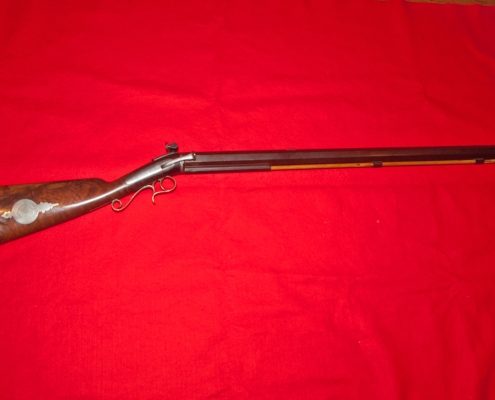
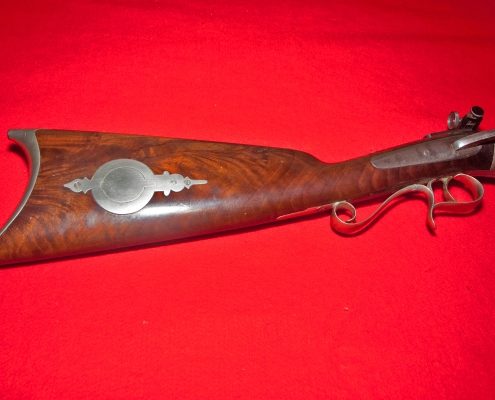
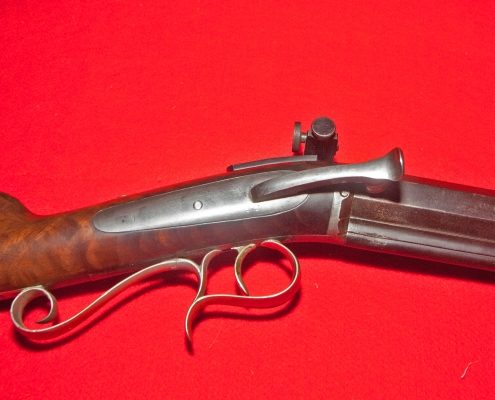
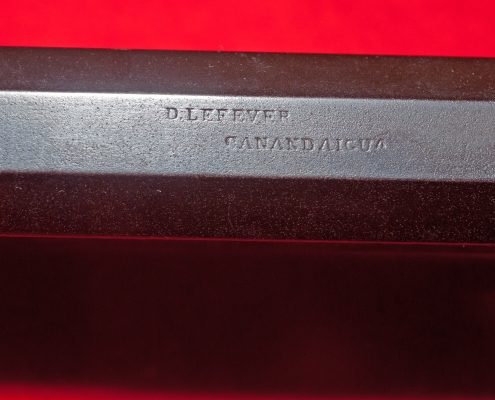
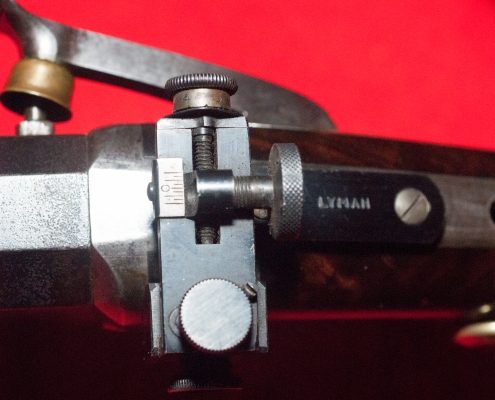
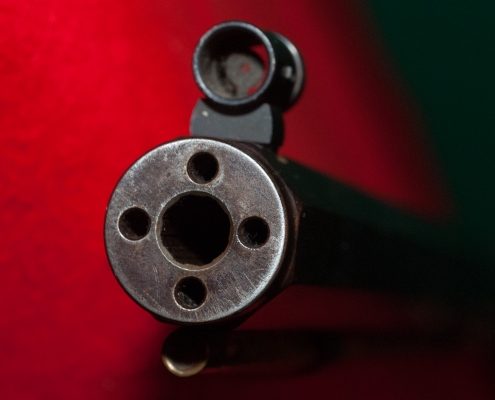

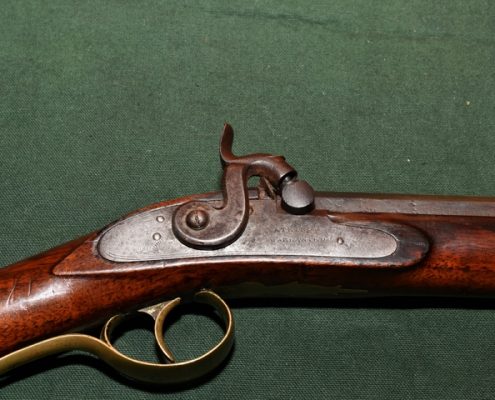
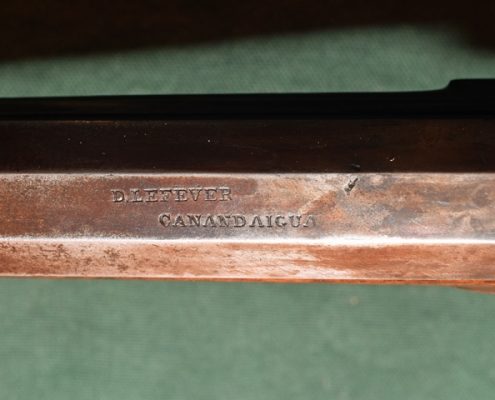
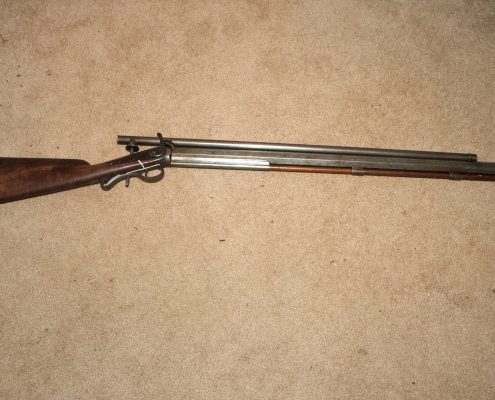
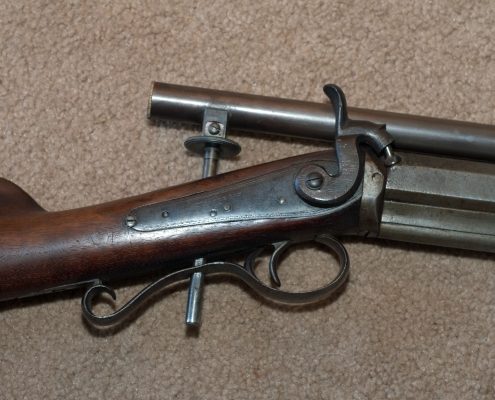
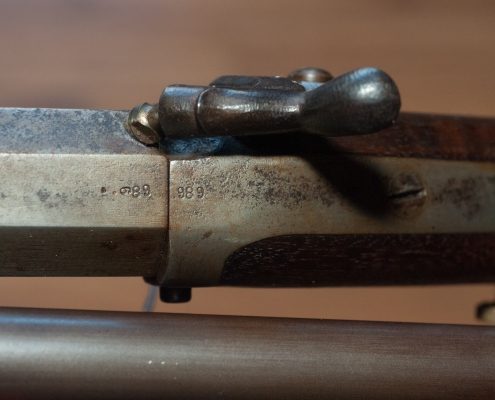
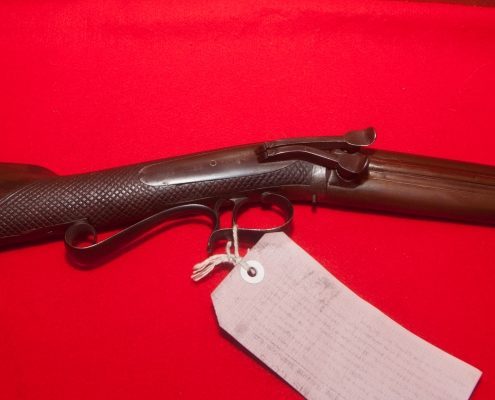
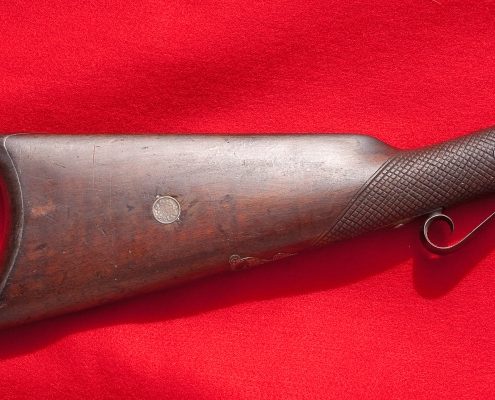
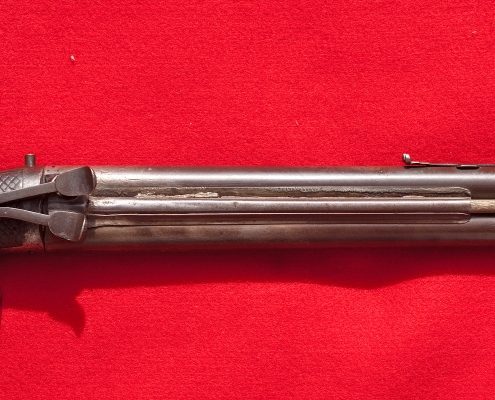
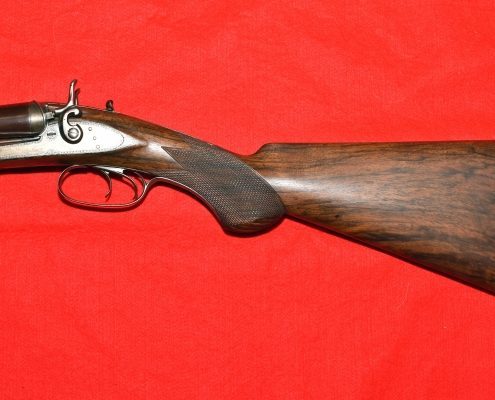
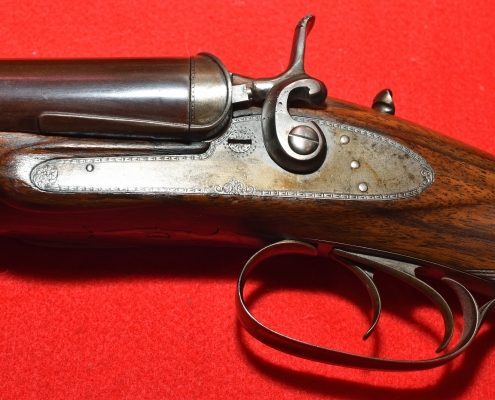
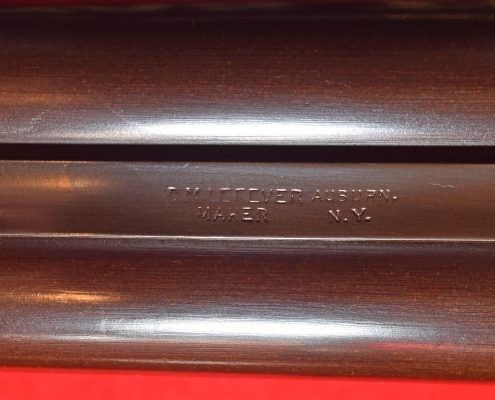
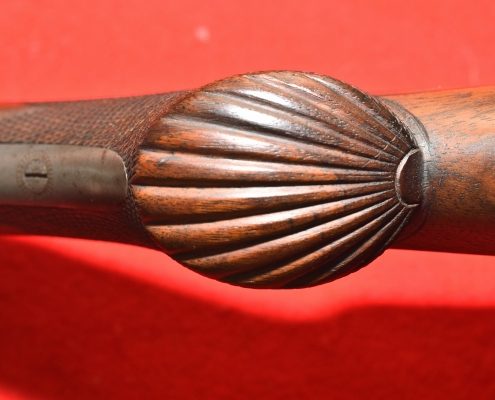
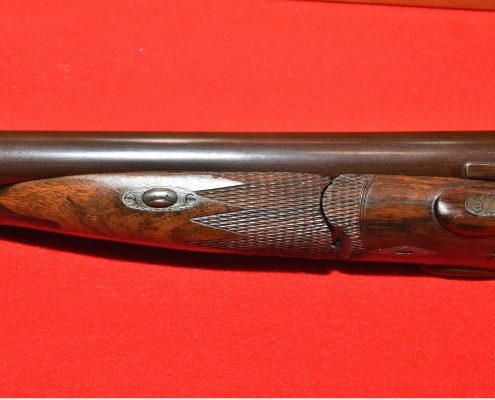
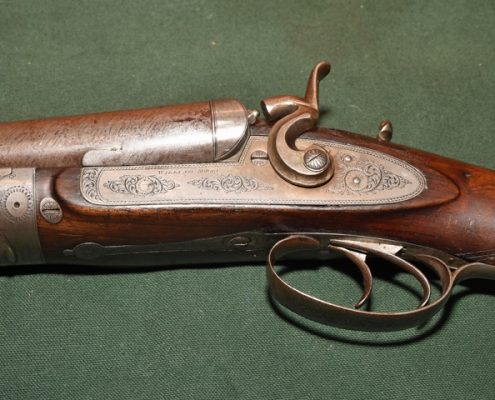
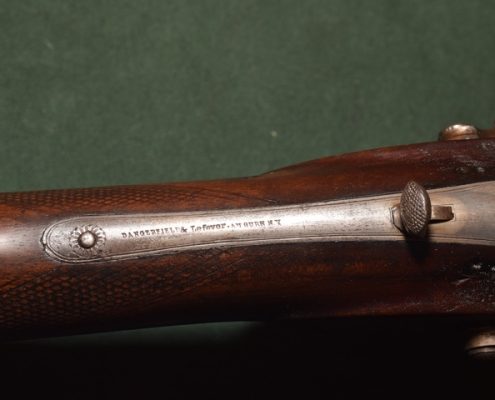
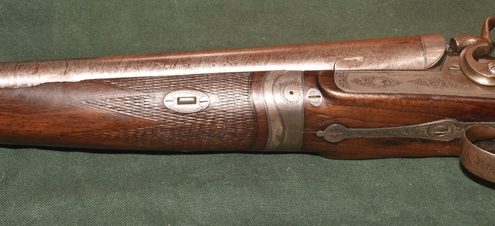
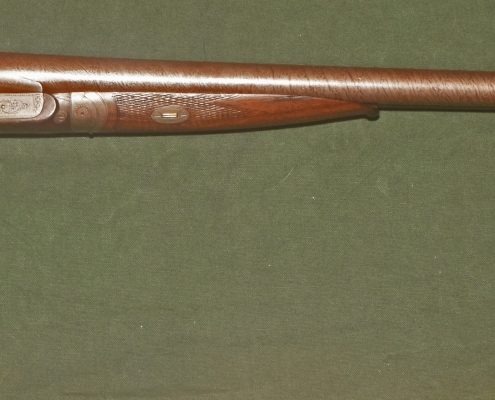
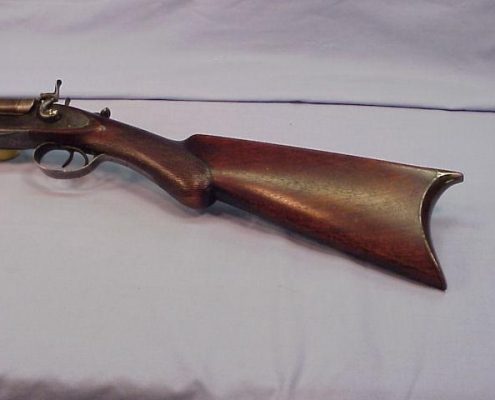
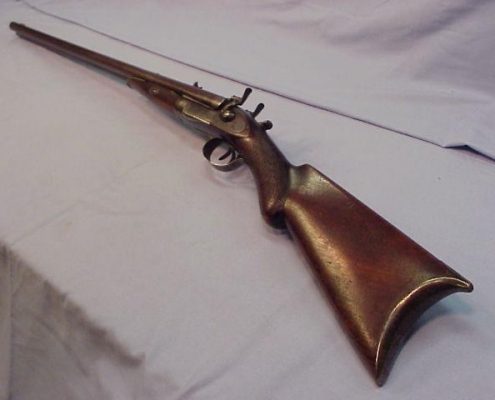
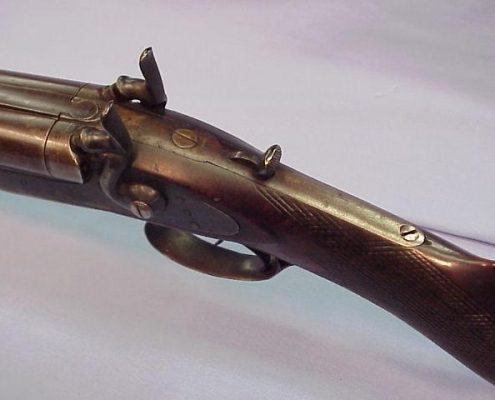
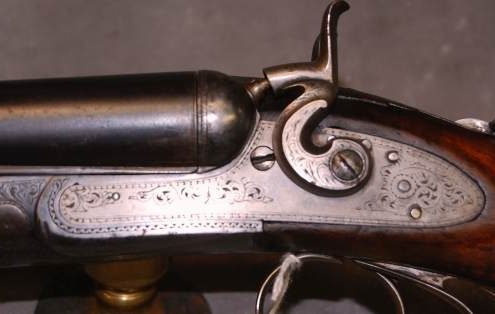
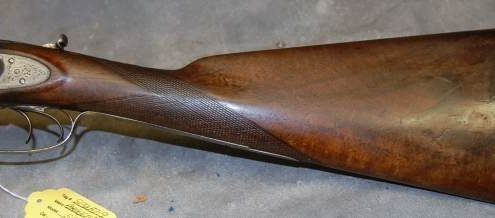
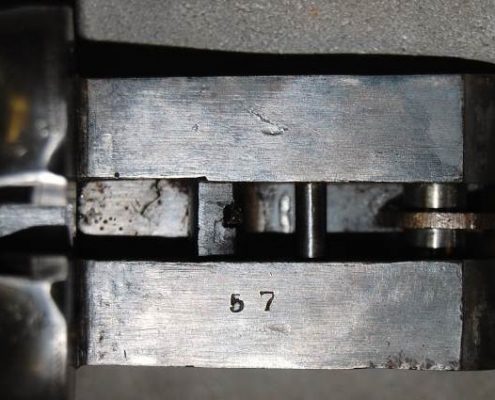
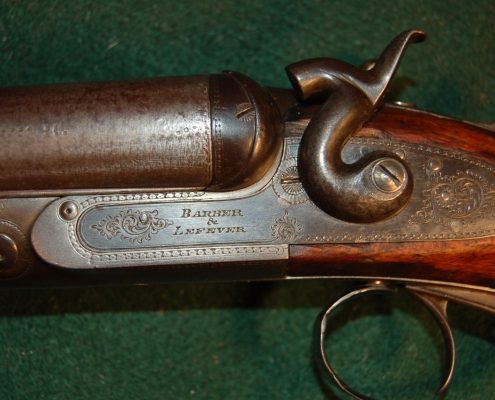
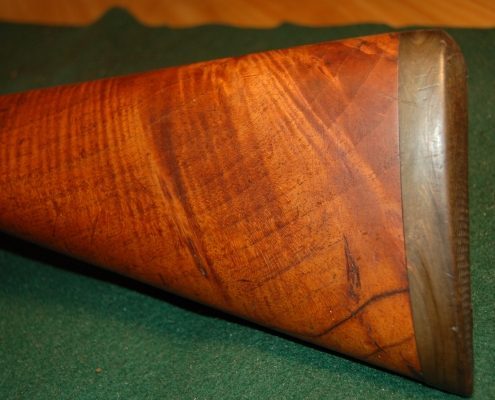
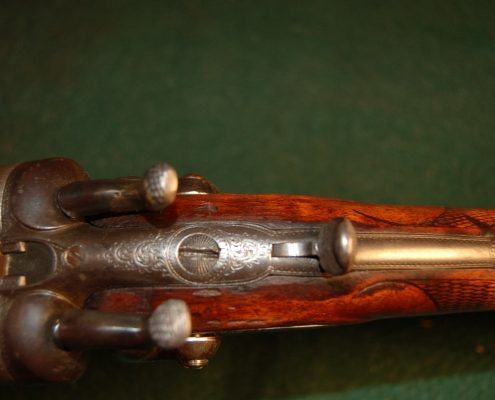
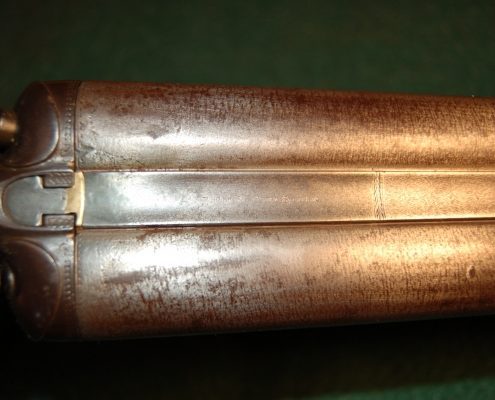
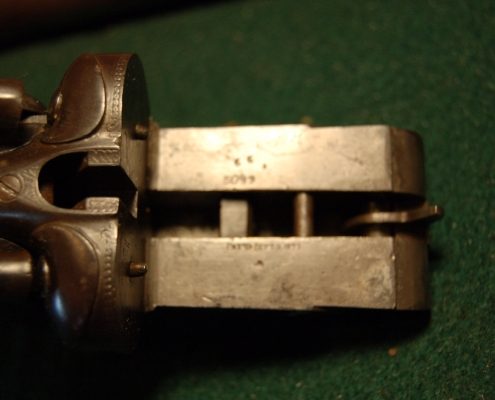
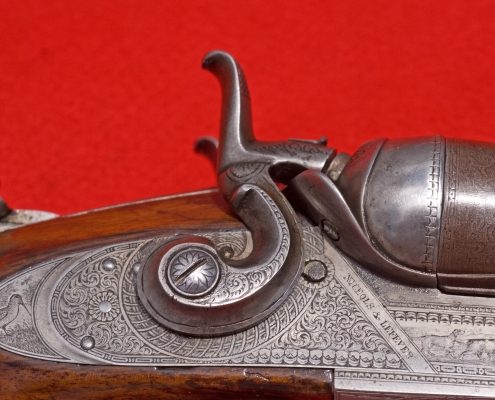
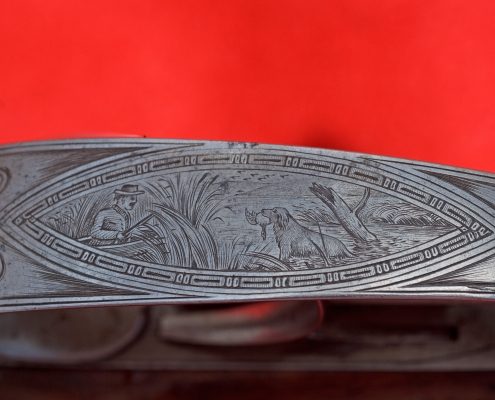
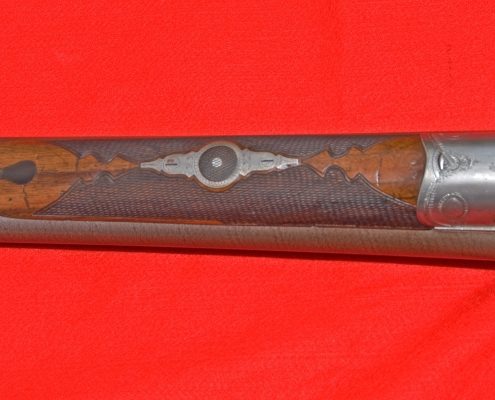
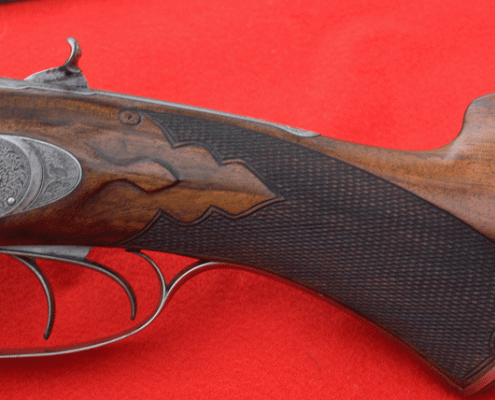
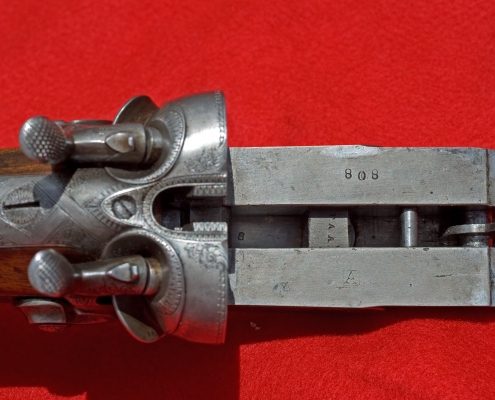
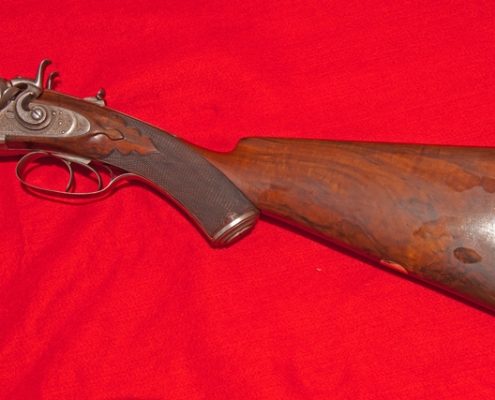
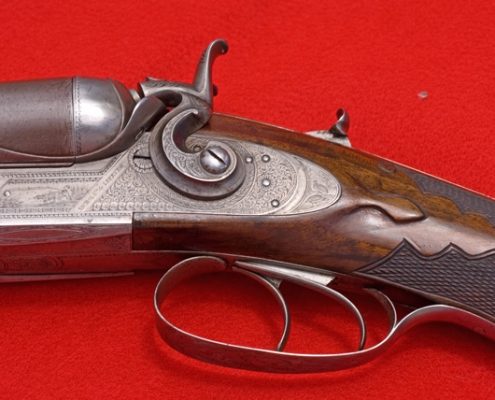
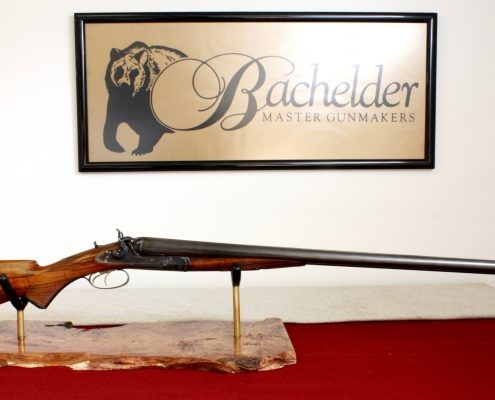
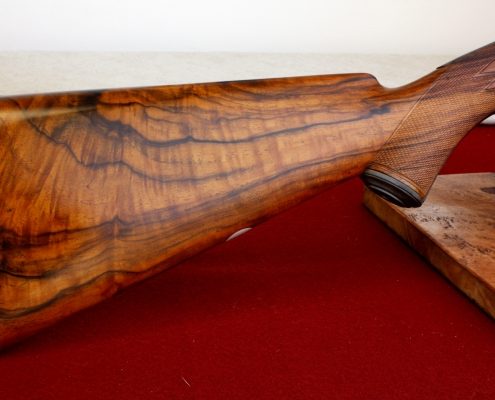
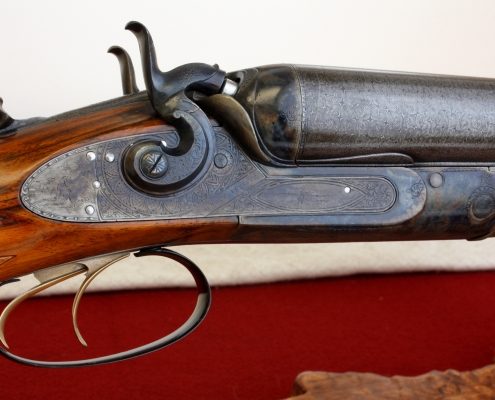
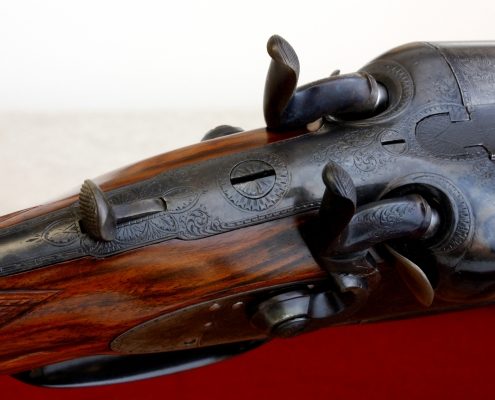
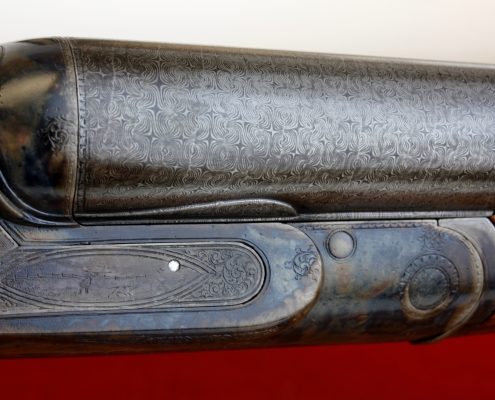
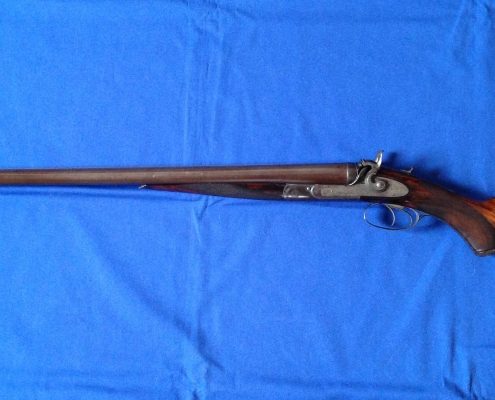
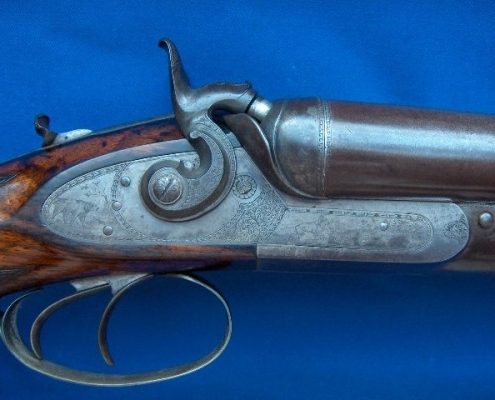
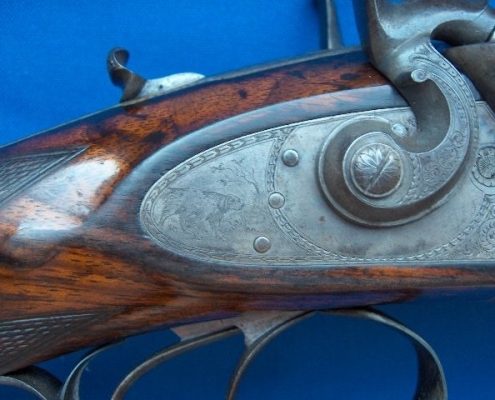
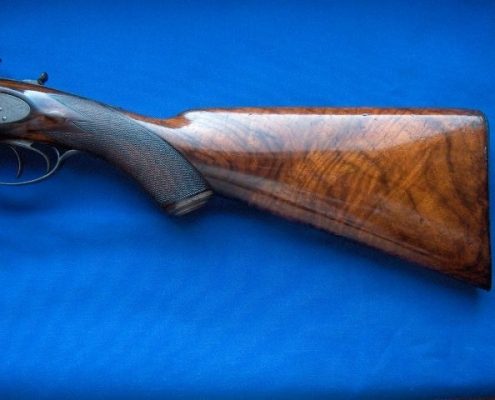
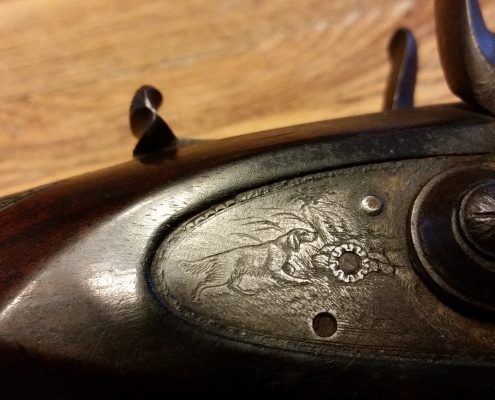
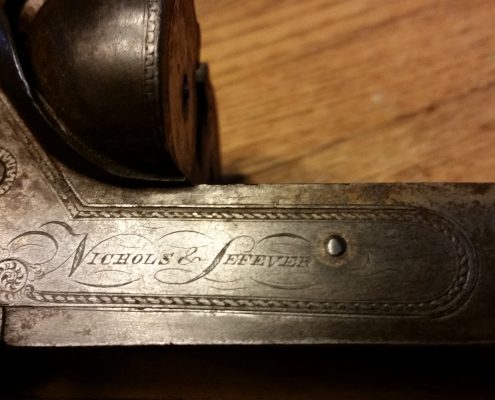
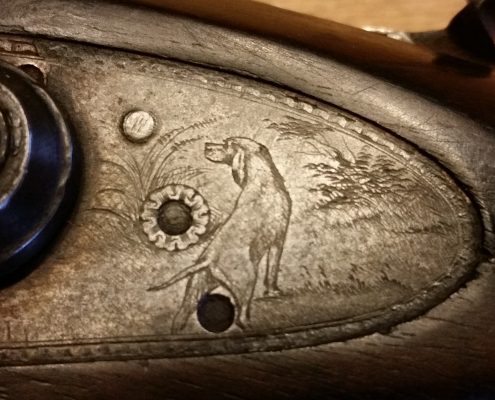
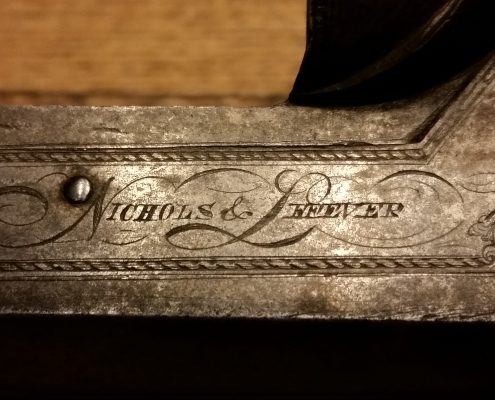
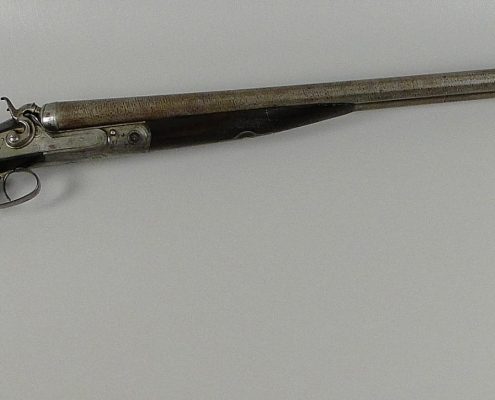
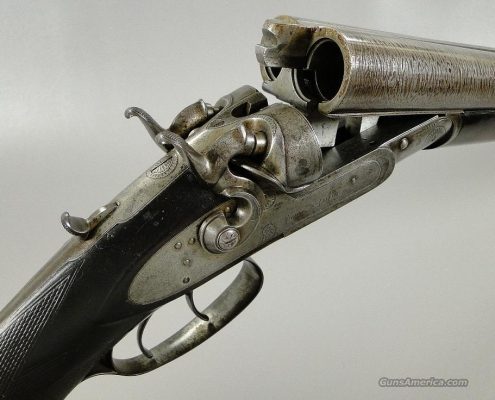
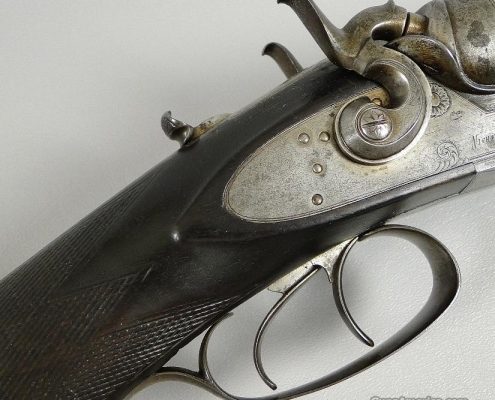
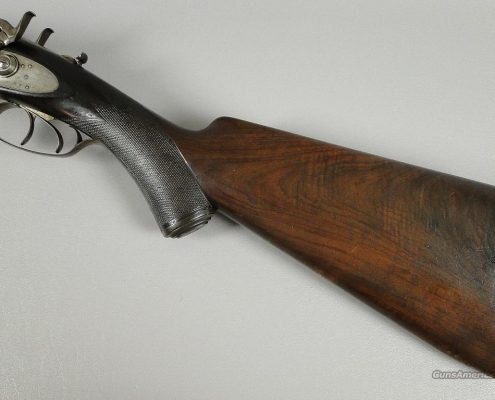
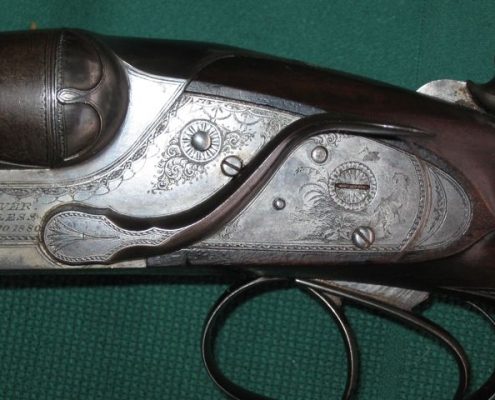
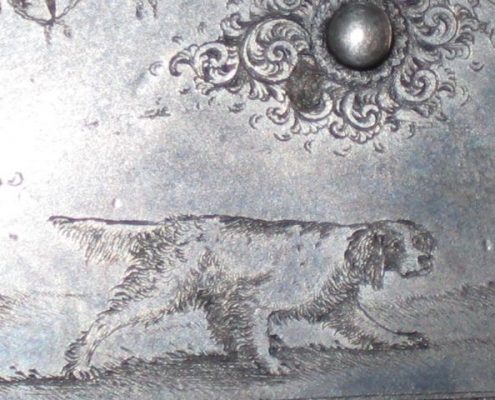
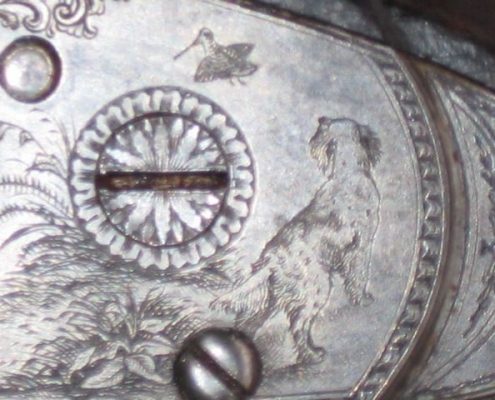
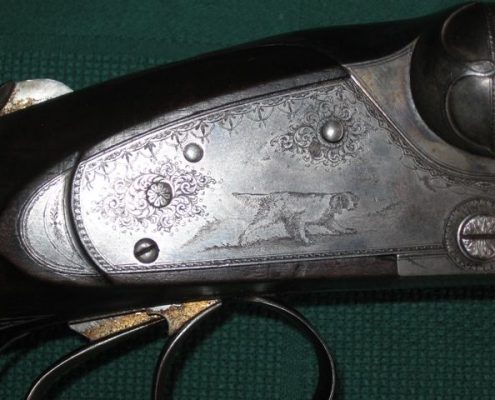
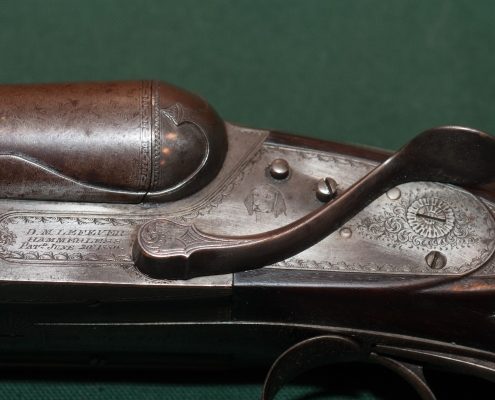
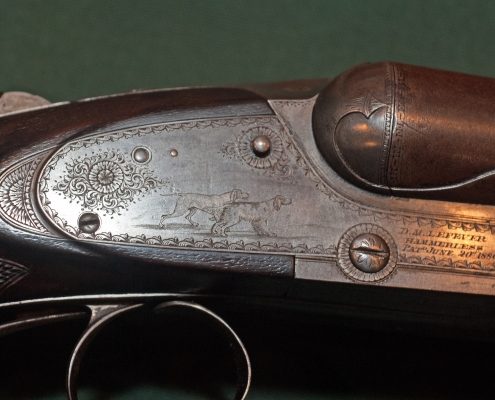
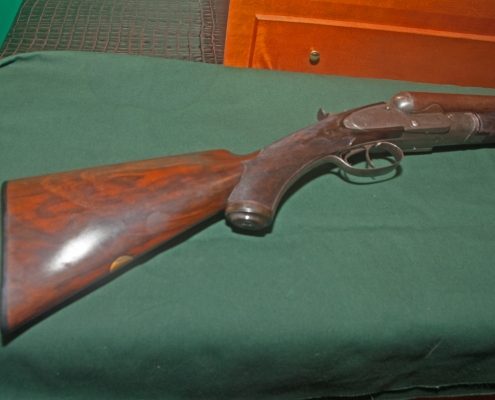
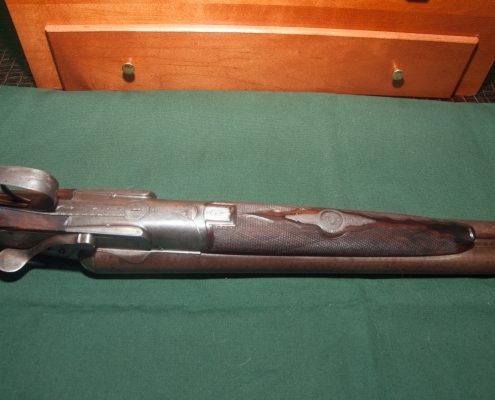
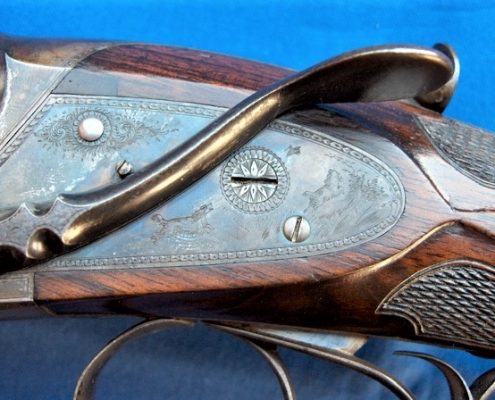
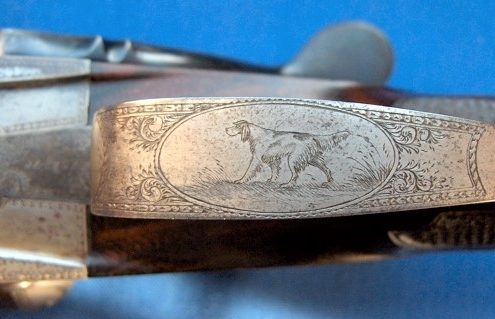
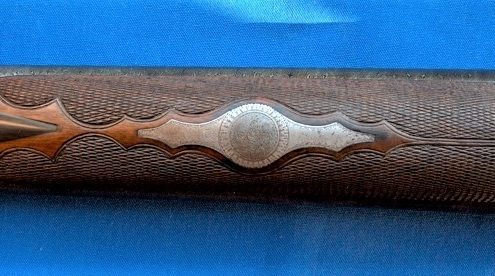
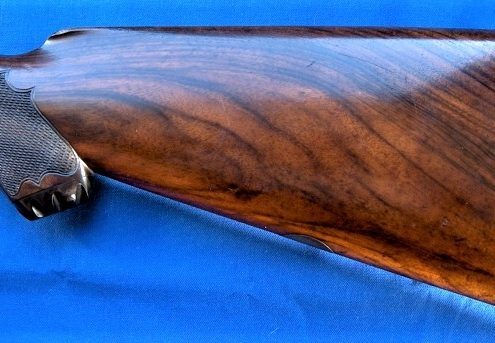
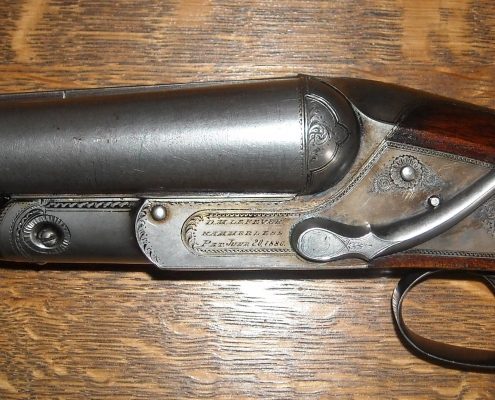
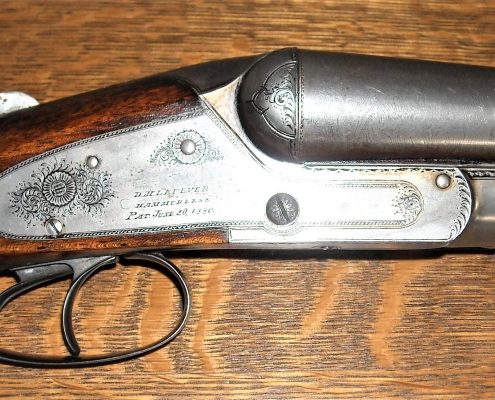
![DSC_1000[2]](https://www.lefevercollectors.com/wp-content/uploads/2020/01/DSC_10002-495x400.jpg)
![DSC_1001[2]](https://www.lefevercollectors.com/wp-content/uploads/2020/01/DSC_10012-495x395.jpg)
![DSC_1003[2]](https://www.lefevercollectors.com/wp-content/uploads/2020/01/DSC_10032-495x271.jpg)
![DSC_1005[2]](https://www.lefevercollectors.com/wp-content/uploads/2020/01/DSC_10052-495x196.jpg)
![DSC_1011[2]](https://www.lefevercollectors.com/wp-content/uploads/2020/01/DSC_10112-495x204.jpg)
